340. 27 April 2007:
The case of the Finnish Rxb2 (+ PS 24 January 2008 to entry 334)
Two interesting Nordic mails today.
Per Manne from Norway drew my attention to yesterday's game Greet - Espen Lie from the Gausdal B tournament.
Greet - Espen Lie, Gausdal B, 26 April 2007
1.e4 Nf6 2.e5 Nd5 3.d4 d6 4.Nf3 dxe5 5.Nxe5 g6 6.g3 Bg7 7.Bg2 O-O 8.O-O c6 9.Re1 Be6 10.Nd2 Nd7 11.Nef3 Nc7 12.Ne4 f6 13.b3 Re8 14.Bb2 Bf7 15.c4 a5 16.a4 Na6 17.Qd2 Qc7 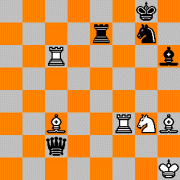 18.Rad1 Rad8 19.Bc3 b6 20.Qb2 Nb4 21.h4 h6 22.Re3 Nf8 23.Rde1 b5 24.axb5 cxb5 25.Nfd2 bxc4 26.bxc4 Rb8 27.Nc5 Nd3 28.Qxb8 Qxb8 29.Nxd3 Qc7 30.Ra1 h5 31.Bxa5 Qd7 32.Bc3 Bh6 33.f4 Ne6 34.d5 Ng7 35.Kh2 g5 36.hxg5 fxg5 37.Ne5 Qc7 38.Nxf7 Kxf7 39.fxg5 Bxg5 40.Rf3+ Kg8 41.Ne4 Bh6 42.Ra6 Kh7 43.Rf7 Qxc4 44.Rc6 Qd3 45.d6 h4 46.dxe7 hxg3+ 47.Nxg3 Kg8 48.Rf3 Qh7 49.Bh3 Qc2+ 50.Kh1 Rxe7
18.Rad1 Rad8 19.Bc3 b6 20.Qb2 Nb4 21.h4 h6 22.Re3 Nf8 23.Rde1 b5 24.axb5 cxb5 25.Nfd2 bxc4 26.bxc4 Rb8 27.Nc5 Nd3 28.Qxb8 Qxb8 29.Nxd3 Qc7 30.Ra1 h5 31.Bxa5 Qd7 32.Bc3 Bh6 33.f4 Ne6 34.d5 Ng7 35.Kh2 g5 36.hxg5 fxg5 37.Ne5 Qc7 38.Nxf7 Kxf7 39.fxg5 Bxg5 40.Rf3+ Kg8 41.Ne4 Bh6 42.Ra6 Kh7 43.Rf7 Qxc4 44.Rc6 Qd3 45.d6 h4 46.dxe7 hxg3+ 47.Nxg3 Kg8 48.Rf3 Qh7 49.Bh3 Qc2+ 50.Kh1 Rxe7
and the position in the diagram is reached, with eleven pieces on the board (Kings included), and no pawns.
Manne wondered if this could be a record - "probably not," as he said. Well, when I searched my database, I found just 25 pawnless positions with 8 pieces, and only two with 9 pieces. So: 11 pieces without pawns really is some record.
The game concluded: 51.Bf1 Re3 52.Bg2 Qd1+ 53.Rf1 Qd7 54.Rxh6 Rxg3 55.Be1 Rxg2 56.Kxg2 Qd5+ 57.Kh2 Qa2+ 58.Rf2 Qa1 59.Bd2 Qe5+ 60.Bf4 Qe4 61.Rh3 Nf5 62.Ra3 Qd4 63.Raf3 Qe4 64.Bb8 Qh4+ 65.Kg1 Qg4+ 66.Kh1 Qe4 67.Kg1 Qg4+ 68.Bg3 Kh7 69.Rxf5 Qxg3+ 70.Kh1 Qe3 71.Rf7+ Kg6 72.R7f6+ Kg7 73.R6f3 Qh6+ 74.Kg1 Qc1+ 75.Rf1 Qg5+ 76.Kh2 Qh6+ 77.Kg1 Qg5+ 78.Kh2 Qh6+ 79.Kg2 Qd2+ 80.R1f2 Qd5 81.Re2 Kg6 82.Ref2 Kg7 83.Kh2 Qe5+ 84.Rg3+ Kh7 85.Kh3 Qh5+ 86.Kg2 Qd5+ 87.Kg1 Qd1+ 88.Rf1 Qd4+ 89.Kh2 Qd2+ 90.Rg2 Qh6+ 91.Kg1 Qe3+ 92.Kh1 Qe4 93.Rff2 Qe1+ 94.Kh2 Qe5+ 95.Rg3 Kh6 96.Rfg2 Kh7 97.Kh1 Qe1+ 98.Rg1 Qe4+ 99.Kh2 Qe2+ 100.R1g2 and a draw was agreed.
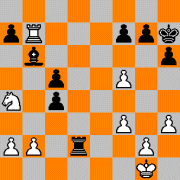 Sampsa Lahtonen from Finland showed me a 15' rapid game he had played with Black just this morning:
Sampsa Lahtonen from Finland showed me a 15' rapid game he had played with Black just this morning:
1.e4 e5 2.Nf3 Nc6 3.Bc4 Bc5 4.O-O Nf6 5.Re1 O-O 6.c3 d6 7.d4 exd4 8.cxd4 Bb6 9.Nc3 Re8 10.Bg5 h6 11.Bxf6 Qxf6 12.Nd5 Qg6 13.Nh4 Qg4 14.Qxg4 Bxg4 15.h3 Bd7 16.Rad1 Ba5 17.Re3 Rad8 18.Bb5 Be6 19.Bxc6 bxc6 20.Nc3 c5 21.dxc5 dxc5 22.Rxd8 Rxd8 23.Nf5 Rd2 24.Na4 Bxf5 25.exf5 c4 26.Re8+ Kh7 27.f3 c5 28.Re7 Bb6 29.Rb7
see diagram
29...Rxb2 30.Nxb2 c3 31.Rxb6 c4 32.Nxc4 c2 33.Rc6 c1Q+ 34.Kh2 Qf4+ 35.Kh1 Qxf5 36.a3 Qb5 37.Rc8 g5 38.Kh2 Kg6 39.g4 Kf6 40.Kg3 Qd7 41.Rc5 Qd4 42.Rc6+ Ke7 43.Kg2 Qd5 44.Rc7+ Kd8 and White resigned.
Of course every Finnish schoolboy knows that this would be a third occurrence of the famous Ortueta - Sanz combination (Spain, 1933), which was anticipated in a Polish game from 1931, Tylkowski - Wojciechowski (see The case of the Polish Rxb2, and entry 327 in this Diary.) Both games, but especially the Polish one, have, unjustly, been thought to be hoaxes - but Lahtonen was right in saying that his game "doesn't look any more composed than the other two." In fact, he thought his very believable game was boring - but he also owned up quickly to having composed it. Which is no mean feat - in my article, I challenged people to do just that, and some tried, but until now no one came up with a believable copycat Rxb2.
We're waiting for a hoaxed Rxb7 now or, why not, the first Rxg7's and Rxg2's.
339. 8 March 2007:
Premiere of a sac
Eduardo Bauzá Mercére wonders whether the following game, which he found in the New York Post of June 1st, 1907, is the oldest example of the classic exchange sacrifice in the (Dragon) Sicilian.
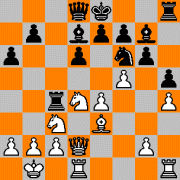 Lawrence - Curt, New York 1907
Lawrence - Curt, New York 1907
1.e4 c5 2.Nf3 g6 3.d4 cxd4 4.Nxd4 Bg7 5.Nc3 Nc6 6.Be3 d6 7.Qd2 Bd7 8.Be2 Nf6 9.f3 a6 10.h4 h5 11.0-0-0 Ne5 12.Kb1 Rc8 13.f4 Nc4 14.Bxc4 Rxc4 15.f5
see diagram
15...Rxc3 16.Qxc3 Nxe4 17.Qa3 gxf5 18.Rhf1 e6 19.Nf3 Bc6 20.Ng5 Qc7 21.Nxe4 Bxe4 22.Rf2 d5 23.Ka1 e5 24.Bc5 Rh6 25.Qa4+ b5 26.Qa3 Rg6 27.b4 f4 28.Re1 Bxg2
 But what I like even better is the final coup: 29.Rxf4 e4+
But what I like even better is the final coup: 29.Rxf4 e4+
The pinned pawn opens two diagonals at once, winning a Rook.
30.Kb1 Qxf4 and White resigned.
PS 10 March: In the latest note to his blog, (#234) Living the Dream: A Coincidence Diary, James Plaskett relates some curious happenings around early occurrences of this sacrifice.
PS 12 March: Eduardo Bauzá Mercére has some interesting information on the second occurrence of the Rxc3 exchange sacrifice, from a simul game of the then reigning World Champion Lasker - and with him on the receiving end.
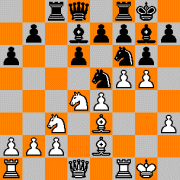 Lasker - Mac Kay, simul Hampstead, Great Britain, 1 February 1908
Lasker - Mac Kay, simul Hampstead, Great Britain, 1 February 1908
1.e4 c5 2.Nf3 Nc6 3.Nc3 g6 4.d4 cxd4 5.Nxd4 Bg7 6.Be3 d6 7.Be2 Nf6 8.h3 O-O 9.O-O Bd7 10.f4 a6 11.g4 Rc8 12.f5 Ne5 13.g5
see diagram
13...Rxc3 14.bxc3 Nxe4 15.Bd3 Nxc3 16.Qe1 Nxd3 17.Qxc3 Nc5 18.f6 exf6 19.gxf6 Ne4 20.Qd3 Nxf6 21.Bg5 Qa5 22.Bd2 Qc5 23.Kh2 Nh5 24.c3 Be5+ 25.Kg2 f5 26.Rab1 Bxd4 27.Qxd4 Bc6+ 28.Kh2 Qe5+ 29.Qxe5 dxe5 30.Bh6 Re8 31.Rfe1 f4 32.Rbd1 Nf6 33.Rd6 Kf7 34.c4 Nh5 and White resigned.
"The curious thing is," Bauzá Mercére writes, "that [Lasker] knew about the sacrifice, because the previous year he had written the notes to the game Lawrence-Curt! But he did not seem to remember it when commenting his loss to 'a Hampstead player'."
Below on the left, Lasker's New York Post column; on the right, the Mac Kay game from Lasker's Chess Magazine, March 1908.

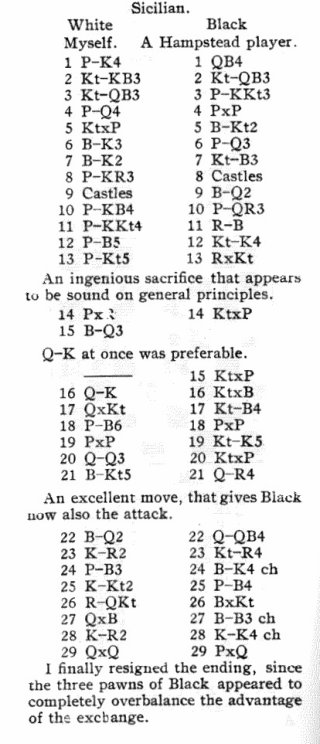
338. 25 February 2007:
A rook house for Bobby
 The portrait on the left is the best I have ever seen of Bobby Fischer.
It features in a clip, titled
A rook house for Bobby by the "post-rock" band iLiKETRAiNS from Leeds, England, and it can be watched on their website or on YouTube. (Or in a live performance, here on YouTube.
The portrait on the left is the best I have ever seen of Bobby Fischer.
It features in a clip, titled
A rook house for Bobby by the "post-rock" band iLiKETRAiNS from Leeds, England, and it can be watched on their website or on YouTube. (Or in a live performance, here on YouTube.
The lyrics go:
They've made mountains out of mole hills
Let them climb
They can chase me to the ends
Of the Earth
And if they find me
Let them indict me
I just don't care any more
They've pushed me too far, too far
They've pushed me too far, too far
All this talk of war
But it's only a game
All I ever wanted to do is play chess with you
But if they find me
They will indict me
I just can't fight anymore
They've pushed me too far, too far
They've pushed me too far, too far
We'll build this rook house here for Bobby
We'll build this rook house here for Bobby
We'll build this rook house here...
iLiKETRAiNS clearly know what they're singing about - the title of the song refers to Fischer's 1962 Harper's Magazine interview with Ralph Ginzburg in which he said that he wanted to live in a house built like a chess rook. And the game shown late in the clip is the last game of his career, the 30th game from his match with Spassky in 1992.
Of course this reminds us of another popsong about Fischer, The Ballad of Bobby Fischer, recorded in 1972 by Joe Glazer & The Fianchettoed Bishops.
No Bishops, fianchettoed or otherwise, can be heard on that disc, nor any real singing - it's some sort of a Country & Western style spoken poem, backed by aimless acoustic guitar riffs. It tells, in 7 minutes, the story of Fischer's life.
He was born in nineteen forty-three
Right away I knew he'd make chess history,
Cause he opened his mouth on the day he was born,
And instead of crying, he said, "Move that pawn
to King four"
When Bobby was three, he went to nursery school
and the things he had to do made him feel like a fool
he had to listen to fairy tales and dance in a ring
but Bobby preferred to do his own thing
like studying the Najdorf Variation of the Sicilian Defence
the kids learned about Red Riding Hood
and all the things that little kids should
about Hansl and Gretl and the wicked old witch
but Bobby, he was studying Nimzovich
(...)
sitting in the classroom he barely could think
cause chess was his food, chess was his drink
(...)
That Bobby Fischer was a chessplaying fool
sharp as a needle, stubborn as a mule
he studied all day and played all night
but he didn't play a match unless things were just right
And I mean right
I mean double right
I mean two hundred percent right
That's right
And so on.
Despite his attempts to innovate
Larsen was bent right out of shape
There's a wikipedia page about Joe Glazer, who died in 2006 at 88.
Thanks to Rowan Marcel for giving me the iLiKETRAiNS link.
PS 26 February: Jan Blom calls my attention to a song by the North-West American folk & blues singer Frank Delaney, the Gary Kasparov Blues, about Kasparov's 1996 win in his match vs. Deep Blue. The link is to the lyrics, which also follow below - the beginning of the song can be heard here.
"I was jogging one day," Delanay writes, "after reading about how the Russian Chessmaster, Gary Kasparov, was playing computer chess against an IBM mainframe computer, and beating it, and this song came to me."
The first lines uncannily resemble Glazer's first lines about Fischer.
Garry Kasparov, Chess Playing Man
When Garry Kasparov was a baby, way back in Ah-zer-bay-john,
he picked up a chessboard and a little white pawn,
said this chess game be the death of me, lord lord, chess game gonna be the death of me.
Well the Chessmaster said to Garry Kasparov,
gonna bring a mainframe 'round,
big IBM mainframe computer, boy, with 32 brains,
gonna whup all your games on down, Lord Lord, gonna whup all your games on down.
Well Garry Kasparov said to the Chessmaster,
a man ain't nothin' but a man,
but before I'd let a mainframe whup me on down,
I'll die with my chessboard in my hand, Lord Lord,
I will die with my chessboard in my hand.
Well Garry Kasparov beat that old mainframe,
yeah he whupped old Deep Blue down,
then he packed up his things, and he headed back home
saying "I'm just chess playin' man, Lord Lord,
Yeah, I'm a chess playin' hewman."
PS 27 February: Pete McCabe writes: "The first lines of the song about Garry Kasparov refer to an old American folk song called John Henry."
When John Henry was a little baby, he was sitting on his daddy's knee.
Well he picked up a hammer and a little piece of steel,
And he said "Hammer be the death of me, Lord Lord, hammer be the death of me."
McCabe adds: "The song is a metaphor for industrialization: John Henry drives rails for the railroad, and one day his boss brings in a steam hammer (called a Steam Drill in most versions of the song.) John Henry competes against the machine, and wins, but dies in the attempt."
And Magnús Teitsson tells me that on Swoon, the 1984 debut album of the British group Prefab Sprout, in the song Cue Fanfare, there are yet some more lines about Fischer.
When Bobby Fischer's plane - plane plane - touches the ground
plane plane he'll take those Russian boys and play them out of town
playing for blood as grandmasters should
PS 20 March: In an earlier version of this item, I made the mistake of thinking that the Gary Kasparov Blues referred to Kasparov's lost match against Deep Blue in 1997, and that Delaney had made a mistake. I owe him an apology for that.
The resemblance between Glazer's song and his, Delaney remarks, is caused by the fact that both are based on the John Henry song.
337. 23 February 2007:
Resignation blunder in Morelia
It only threw away half a point, but at that level, Topalov's mistaken resignation against Carlsen in yesterday's game in Morelia, was still an unusual occurrence.
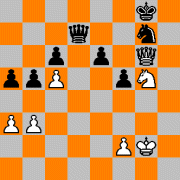 Black to play
Black to play
Carlsen - Topalov
Morelia, Round 5, 22 February 2007
White threatens Qh7+ Qh8+ and Qxg7+, and 64...Kf8 65.Nh7+ doesn't help.
As Henrik Carlsen, Magnus' father, writes in his blog: "After thinking for about 5 minutes, Topalov resigned, and just shook his head when Magnus showed him the defence." Which was perhaps hard to see, being available only by chance: 64...Qd5+ 65.Kh2 e5 and now 66.Qh7+ Kf8 67.Qh8+ Qg8 68.Nh7+ Kf7 69.Ng5+ Kf8 etc.
336. 25 January 2007:
A hole in the head
I had a dream about Kramnik tonight.
He had visited me in my house in Amsterdam, being extremely cheerful and happy. I was amazed how tall he was. Although we were speaking English, I thought: "His Dutch is impressive, he's really fluent. I never even knew he spoke Dutch."
As we went outside, I told him I had this new idea for time controls, the Krabbé-clock. Thinking time should not go down as the game progressed, but up. "Every grandmaster knowing the first twenty moves of every opening these days," I said, "five minutes for the first twenty moves should be enough. After that, you get an hour for every twenty moves. That way, you can play decent endgames again."
"What a wonderful idea!" he exclaimed, "yes, that's what we must do." And he started explaining that he had done some research into this himself - if you did not count the book moves, and the trivial moves, like taking back a piece in an exchange, then the average thinking time... But in mid-explanation, the cheerfulness was gone, and he stood still on the sidewalk, deeply concerned. "I'm afraid my mind is going," he said, "I have a hole in my head." Not too long ago, he had been attacked by somebody who had stuck a knife in his forehead. "Look," he said, a little reproachful now, "haven't you noticed?" And now I saw that high on his forehead, where Hindus have that mark, barely visible under a cap he now seemed to be wearing, he had a contraption, resembling a small black inkpot, its neck covering the hole. This way, his mind would stay inside his head.
But somehow the concern was gone, the cheerfulness was back, I didn't know about the inkpot and the cap anymore, and we walked on. In Leidsestraat, he started shopping for clothes and we said goodbye. A second later, worrying that maybe I had not said goodbye, I started looked for him, and I saw him in a shop, already trying on some clothes. It was OK then, and I hailed a cab, which started the trip as a ghostrider, on the wrong side of the street - but the chess part of the dream had ended.
335. 22 January 2007:
Backrankers
Steffen Slumstrup, Bernd Kohlweyer and this morning's Chess Today (Slumstrup even while it was still being played) called my attention to this game from the Corus-C tournament.
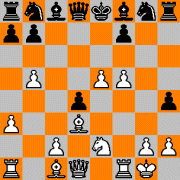 N. Kosintseva - Berg, 8th round Corus-C, 22 January 2007
N. Kosintseva - Berg, 8th round Corus-C, 22 January 2007
1.e4 e6 2.d4 d5 3.Nc3 h6 4.Bd3 c5 5.dxc5 d4 6.Nce2 Nc6 7.Nf3 Bxc5 8.O-O Nge7 9.a3 e5 10.Ng3 h5 11.b4 Bd6 12.Nh4 Ng8 13.Nhf5 Bf8 14.b5 Nb8 15.f4 h4 16.Ne2 g6 17.fxe5 gxf5 18.exf5
see diagram
18...Nd7 19.e6 Ne5 20.Bf4 Qd5 21.Bxe5 Qxe5 22.Nf4 Nf6 23.exf7+ Kxf7 24.Qb1 Kg7 25.Qb3 Bd6 26.Rae1 Qc5 27.Ng6 Rh5 28.Nf4 Rg5 29.Nh3 Rg4 30.Qb1 Qd5 31.Rf2 Bd7 32.Be2 Qe5 33.Bxg4 Qxh2+ 34.Kf1 Nxg4 35.f6+ Nxf6 36.Qb3 Qh1+ 37.Ng1 Rf8 38.a4 Bh2 39.Re7+ Kh8 40. Ke2 Qxg1 41.Qf3 Bg4 42.Qxg4 Qxf2+ and White resigned.
There are a dozen other games where all the pieces were again (or still) at the back rank at or after move 16, including the famous Lasker - Steinitz, Hastings 1895 (see the Palview board), but Berg does now share a record: that of the latest backranker (move 17) who won the game.
Here is the even more spectacular (and also quite famous) game he shares it with.
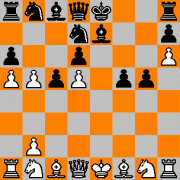 Diemer - Heiling, Nuremberg 1984
Diemer - Heiling, Nuremberg 1984
1.d4 Nf6 2.f3 d6 3.e4 g6 4.g4 Bg7 5.g5 Nfd7 6.f4 c5 7.d5 b5 8.c3 a6 9.h4 Nb6 10.h5 e6 11.h6 Bf8 12.a4 exd5 13.a5 N6d7 14.exd5 Be7 15.c4 f6 16.cxb5 fxg5 17.f5 gxf5
see diagram
After starting the game with 17 pawn moves (a record in itself), White makes a first piece move: 18.Qh5+ Kf8 19.Nf3 Rg8 20.b6 Bb7 21.Nc3 Nf6 22.Nxg5 Nxh5 23.Ne6+ Ke8 24.Nxd8 Ng3 25.Nxb7 Nxh1 26.Bf4 Rg6 27.O-O-O Nf2 28.Re1 Kd7 29.Nb5 Ne4 30.Rxe4 Rg1 31.Re1 Rxf1 32.Rxf1 axb5 33.Rg1 Kc8 34.Nxd6+ Bxd6 35.Bxd6 Nd7 36.Rg8+ Kb7 37.Rg7 Kc8 38.Rxh7 Rxa5 39.b7+ Kxb7 40.Rxd7+ Kc8 41.h7 Ra1+ 42.Kc2 Kxd7 43.h8Q Kxd6 44.Qd8+ Ke5 45.d6 and Black resigned.
The latest position I found with all the pieces at the back rank was at move 22.
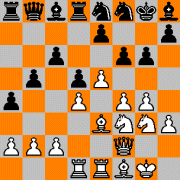 Lastin - Tseshkovsky, ch Russia, Elista 1995
Lastin - Tseshkovsky, ch Russia, Elista 1995
1.e4 d6 2.d4 Nf6 3.Nc3 g6 4.Nf3 Bg7 5.Be2 O-O 6.O-O c6 7.Re1 Nbd7 8.Bf4 Qb6 9.Rb1 a5 10.Bf1 Rd8 11.Qe2 Nf8 12.h3 Be6 13.Be3 Qc7 14.Rbd1 d5 15.e5 Ne8 16.Ng5 Bc8 17.f4 b5 18.Qf2 f6 19.Nf3 Qb8 20.g4 a4 21.Ne2 Bh8 22.Ng3
see diagram
22...Ng7 23.Bd3 f5 24.gxf5 Nxf5 25.Nxf5 Bxf5 26.Bxf5 gxf5 27.Kh2 Ra7 28.Rg1+ Bg7 29.Rg2 e6 30.Rdg1 Rdd7 31.Ne1 Qe8 32.Nd3 h6 33.Bd2 Rf7 34.Bb4 Kh7 35. Qh4 Rfc7 36.Bc5 Rab7 37.Bd6 Rf7 38.Nc5 Ra7 39.Qh5 Qc8 40.Bxf8 and Black resigned.
It reminds me of this:
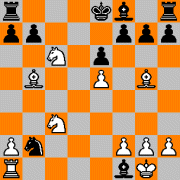 Dzindzichashvili - Sakharov, USSR 1957
Dzindzichashvili - Sakharov, USSR 1957
1.e4 c5 2.c3 Nf6 3.e5 Nd5 4.d4 cxd4 5.cxd4 d6 6.Nf3 Nc6 7.Be2 Bf5 8.O-O dxe5 9.dxe5 e6 10.Bd2 Ndb4 11.Nc3 Nd3 12.Bg5 Nxb2 13.Qxd8+ Nxd8 14.Bb5+ Nc6 15.Nd4 Bd3 16.Nxc6 Bxf1
see diagram
17.Bxf1 bxc6 18.Bc1 Ba3 19.Nb1 and Black resigned - White finishes the game by moving three pieces back to their original squares.
For a hilarious endgame study and problem with the backrank theme, see item 289 in this diary.
334. 4 January 2007:
The worst possible move
The blatant stalemate swindle of El Idrissi - Laaroussi in item 333 below, led study composer (and some other things, see
here, if you know Dutch) Noam Elkies to remark that 51.Bf8 is White's worst move in the sense that it's the only one that doesn't win. (Very probably, even 51.Ne4, which loses two pieces, wins.)
This in turn gave me the idea of a new task: The worst possible move. Different definitions of such a move come to mind, but this seems obvious:
White has n moves, (n-1) of which would mate Black in 1; the nth forcing Black to mate him in 1.
Of course a higher n means a worse move.
Not surprisingly, Elkies almost immediately came back with a fresh record of n=28.
 White to play
White to play
The worst possible move
Noam Elkies, december 2006 (after H.H. Cross, 1936)
White has 28 moves, 27 of which mate Black on the spot. A momentary lapse however, could lead White to play 1.Qxc5+, after which 1...Nxc5 mate is forced.
Below is the position Elkies modified for his record - a record in itself, which could be called "The best possible position."
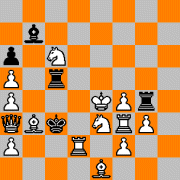 White to play
White to play
29 forced mates
H.H. Cross, Problemist Fairy Supplement, 1936
White is forced to mate Black - 29 mates with that stiputation has never been surpassed.
PS 5 January: With constructions like these, a distinction is usually made between positions that are
- legal, without promoted men
- legal, with promoted men
- illegal
Cross' 'Best possible position' falls in that first category, and I'd never seen records for this task in the other categories. Now Sasho Kalajdzievski sent me this (legal) position with promoted men where White has 31 forced mates in 1.
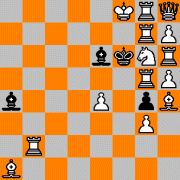 White to play
White to play
31 forced mates (legal; promoted men)
Sasho Kalajdzievski, original, 2007
PS 6 January: Joaquim Crusats came up with a big improvement of Kalajdzievski's matrix: with 3 men less, he achieved 2 more mates.
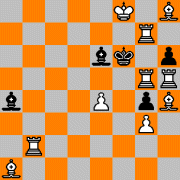 White to play
White to play
33 forced mates (legal; promoted men)
Joaquim Crusats (after Kalajdzievski), 2007
Moreover, Crusats also modified this position for a worst possible move (in this category of legal positions with promoted men) of n=33:
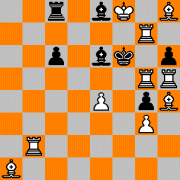 White to play
White to play
Worst possible move, n=33 (legal position, promoted men)
Joaquim Crusats, 2007
White has 33 moves, 32 of which are mate, the 33rd, Rxh6+ being "a really, really, very bad idea."
PS #2, 6 January:
"I am convinced that this will be improved," Crusats wrote and indeed, it wasn't too difficult to add two forced mates to his 33 with an extra Bishop battery:
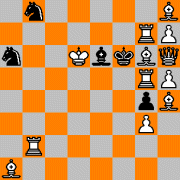 White to play
White to play
35 forced mates (legal; promoted men)
Tim Krabbé (after Kalajdzievski & Crusats), 2007
But like Crusats, I'm convinced this can go quite a lot higher.
PS 8 January: Adding yet another battery, Noam Elkies goes to 40 forced mates in this category.
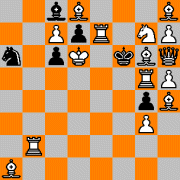 White to play
White to play
40 forced mates (legal; promoted men)
Noam Elkies, 2007
Elkies remarks that the Ng7 could be replaced by any black piece; the three Knight-mates would disappear then, but there would be three new mates capturing the piece on g7, the total remaining 40.
PS 10 January: Two new records in the related tasks of the "Best possible position" and the "Worst possible move" by Noam Elkies, with 43 forced mates, and n=41 respectively.
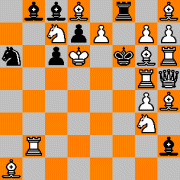 White to play
White to play
43 forced mates (legal; promoted men, promotion moves)
Noam Elkies, 2007
The position is legal; White has 4 promoted men, and 4 pawns are missing. It must be noted however that with these tasks, a further distinction is sometimes made between "with promotion moves", and "without promotion moves" - it could be argued that the 16 promotions of the e7 and g7 pawns, are really only 4 different moves. The without record is still the 40 forced mates of Elkies' previous construction.
More important, Elkies also managed to modify his "43 forced mates" construction into a "Worst possible move" of n=41.
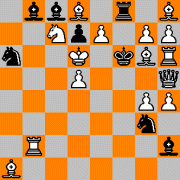 White to play
White to play
Worst possible move, n=41 (legal position, promoted men, promotion moves)
Noam Elkies, 2007
White has 41 moves, 40 of which are mate in 1, the 41th, Qf5+, forcing Black to mate him in one. Again, this is "with promotion moves". The record for without still stands at n=33, by Crusats.
In Elkies' last three constructions, I'm not doing what he asked me to do - add an "after" after his name as the composer. The matrix that he improved upon is too obvious, and his improvements are too good for that.
PS 2, 10 January: A mail from Richard Stanley leaves me feeling rather sheepish, and awkward towards Elkies and Crusats - Stanley points to a position with 50 forced mates (legal, promoted men, no promotion moves) which has been composed as far back as in 1967. It's like a retro Beamon jump.
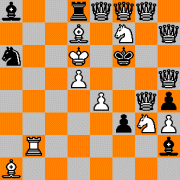 White to play
White to play
50 forced mates (legal; promoted men, no promotion moves)
Wolfgang Dittmann, Die Schwalbe 1967
There are 14 mates by Rb2; 1 by Pe4; 8 by Qg4; 6 by Qh5; 5 by Qh7; 4 by Qg8; 3 by Qf8; 4 by Qe8 and 5 by Nf7, for a total of 50. The position is easily legal.
Although the whole idea is completely different, it's remarkable how much of the matrix is the same as in the evolving position that was found here, starting with Kalajdzievski. Same position of the Kings, same Ba1-Rb2 battery, same sort of confinement of the white King, and Dittmann even anticipated Elkies' Bh2-Ng3 pin.
It should not be too difficult to make a "Worst possible move" of at least n=45 out of this.
PS 11 January: Joaquim Crusats modified Dittmann's position to a "worst possible move" (legal; promoted men, no promotion moves) of n=44.
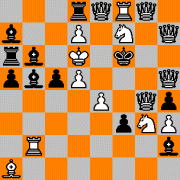 White to play
White to play
Worst possible move, n=44 (legal position, promoted men, no promotion moves)
Joaquim Crusats (after Dittmann), 2007
White has 44 moves, 43 of which are mate, the 44th forcing Black to mate him: 1.Qxd8+ Bxd8 mate.
PS 2, 11 January: A lot more was possible in this set-up, as was shown by Kasper Henriksen and Joaquim Crusats who sent me, in less than 2 hours of each other, practically the same "worst possible move" of n=47 magnitude.
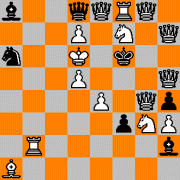 White to play
White to play
Worst possible move, n=47 (legal position, promoted men, no promotion moves)
Joaquim Crusats and Kasper Henriksen (after Dittmann), 2007
White has 47 moves, 46 of which are mate, the 47th forcing Black to mate him: 1.Qe7+ Qxe7 mate.
Although Henriksen was first, I see him and Crusats as joint record-holders, because Henriksen has a Bishop on d7 which is very slightly less economical, and the position he first sent me needed a little correction. (See PS 24 January 2008 below.)
PS 24 January: As a footnote, Michael Kanellos adds a different sort of very bad move.
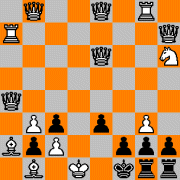 White to play
White to play
Michael Kanellos, 2007
In this legal position, White has 83 moves, 82 of which are "no-brainer" mates in 2, the 83rd (White's only possible capture) leading to an immediate draw. For an explanation of the term "no-brainer", and a few examples, see
item 267 in this Diary.
PS 30 January: Joaquim Crusats took Kanellos' idea of combining the "worst possible move" with "no-brainer" mates, a step further.
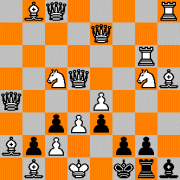 White to play
White to play
Worst possible move n=93 (legal position, promoted men, "no-brainer" version)
Joaquim Crusats, after Michael Kanellos, 2007
White has 93 moves, 92 of which are no-brainer mates, the 93th not creating a stalemate, but a no-brainer selfmate.
PS 23 February: With a much nicer position, Joaquim Crusats breaks his own record in this domain by 56.
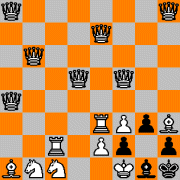 White to play
White to play
Worst possible move n=149 (legal position, promoted men, "no-brainer" version)
Joaquim Crusats, original, 2007
White has 149 moves, of which one is mate in 1, 147 are no-brainer mates in 2, and the 149th is a no-brainer selfmate.
PS 8 March: With two pieces less, Joaquim Crusats achieves a new major improvement.
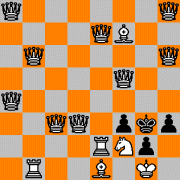 White to play
White to play
Worst possible move n=178 (legal position, promoted men, "no-brainer" version)
Joaquim Crusats, original, 2007
White has 178 moves, 177 of which are no-brainer mates in 1 or 2, the 178th being selfmate in 1.
PS 24 January 2008: Again using Dittmann's matrix, Alexey Khanyan breaks Crusats' and Henriksen's record for the "Worst possible move, (legal position, promoted men, no promotion moves) of n=47, and brings it to n=48.
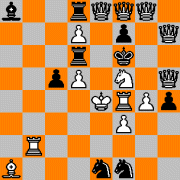 White to play
White to play
Worst possible move, n=48 (legal position, promoted men, no promotion moves)
Alexey Khanyan (after Dittmann), 2008
White has 48 moves, 47 of which are mate, the 48th (Qe6+) forcing Black to mate him: in one.
333. 17 & 19 December 2006:
Miscellaneous curiosities
A clean sweep of the curiosities that had piled up in my Inbox over the last few weeks.
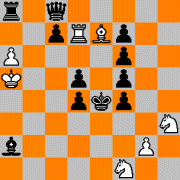 White to play and win
White to play and win
M. Bent
Shakhmaty v SSSR, 1966
Two days ago, I published this as a study by A. Lilienthal(?). That is how Miron Cristea had found this position in an almanac named Anticipatia. I doubted that very much (just one small study by Lilienthal can be found in the Van der Heijden database, and no problems are known) and now two readers, Jarl Ulrichsen and Ian Watson, have come forward to return it to its rightful owner, the English study composer Mike Bent (1919 - 2004). (See for his obituary here.)
1.Nf2+ Ke5 2.Nd3+ Ke6 3.Nc5+ Ke5 4.Bd6+ cxd6 5.Re7+ Qe6 6.Rxe6+ fxe6 7.Nd3+ Ke4 8.Nf2+ Ke5 9.Nd2 Rxa6+ 10.Kxa6 Bc4+ 11.Ka5 Be2 12.Kb4 Now Black can only stave off the fatal Zugzwang with his remaining pawn moves. 12...d3 He can always choose between playing a d-pawn and an f-pawn. 13.Kc3 d4+ 14.Kc4 d5+ 15.Kc5 f3 16.g3 f4 17.g4 f5 18.g5 and Nxd3 mate or Nxf3 mate next move.
A very nice study, showing, among other things, the doubled "caterpillar" theme. Originally, I called it "a very nice problem", which is why I failed to look it up in the Van der Heijden database. If I had, I would have discovered the Bent authorship before.
It is sometimes difficult, especially with longer compositions, to tell the difference between a study and a problem. In stamping it as a problem, I belied my own insight that the theme must be called forward by the stipulation. Here, the play results from White's task of winning at all - the number of moves in which he mates is accidental. But even more important, as Watson writes: "As to whether it is a study or a problem, I suppose that as Mike chose to call it a study, it is de facto a study."
Bent had composed an earlier version of this study - is that why it turned up in this almanac "Anticipatia"?
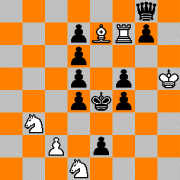 White to play and win
White to play and win
M. Bent
1st Prize Joseph Jubilee Tourney, 1965
1.Nd2+ Ke5 2.Nf3+ Ke6 3.Ng5+ Ke5 4.Bf6+ gxf6 5.Re7+ Qe6 6.Rxe6+ dxe6 7.Nf3+ Ke4 8.Nd2+ Ke5 9.Nf2 e1N 10.Kh4 d3 11.c3 Ng2+ 12.Kh3 Ne1 13.Kh2 f3 14.Kg3 f4+ 15.Kg4 d4 16.c4 f5+ 17.Kg5 d5 18.c5 and mate next move.
PS 4 January 2007: Arpad Rusz solves the Lilienthal/Bent mistery. He writes: "In Shakhmaty v SSSR (12/1972) there is a short story with the title The fatal dream signed by A Lilienthal. A chessplayer (who is playing black in a adjourned game) has a nightmare seeing a strange reciprocal zugzwang position. He is happy that it is just a dream. But their game finally ends with that zugzwang. Of course the adjourned position was exactly Bent's study - as specified by a footnote too."
And Ian Watson solves a mystery of the study itself. If Bent had already won a First Prize with the 1965 version, he wondered, then why did he compose "a new and less attractive version if the earlier and better one were sound?" Suspecting a cook might be the explanation, Watson did indeed find one in 4.Kg6 (threatening 5.Rxf5 mate), giving these variations: 4...d3 (4...Qxf7 5.Nxf7+ Ke6 6.Bf8 f3 7.Nf2 e1N 8.Ng5+ Ke5 9.N2h3 and mate next move) 5.c3 Qe8 6.Nf2 e1N and now both 7.Bf8 and 7.Kxg7 seem to be easy wins.
Peder Berkell had been going over my article on forks, without seeing an example of a special fork he had once been able to deliver.
Berkell - Engström, Swedish Open 1977
 1.d4 Nf6 2.c4 g6 3.Nc3 d5 4.cxd5 Nxd5 5.e4 Nxc3 6.bxc3 Bg7 7.Bc4 O-O 8.Ne2 c5 9.O-O cxd4
1.d4 Nf6 2.c4 g6 3.Nc3 d5 4.cxd5 Nxd5 5.e4 Nxc3 6.bxc3 Bg7 7.Bc4 O-O 8.Ne2 c5 9.O-O cxd4 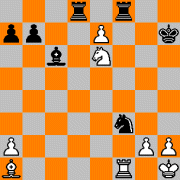 10.cxd4 Nc6 11.Be3 Bg4 12.f3 Na5 13.Bd3 Be6 14.d5 Bxa1 15.Qxa1 f6 16.Qd4 Bd7 17.e5 e6 18.Nf4 fxe5 19.Qxe5 Qb8 20.Qg5 Qd8 21.Qe5 Qb8 22.Qg5 Qd8 23.Qh6 Qe7 24.dxe6 Be8 25.Bd4 Rd8 26.Ba1 Nc6 27.Bxg6 Nd4 (see diagram) 28.Bxh7+ Qxh7 29.Qxh7+ Kxh7 30.e7 Nxf3+ 31.Kh1 Bc6 32.Ne6 (see diagram right) with a deadly double fork. Black resigned.
10.cxd4 Nc6 11.Be3 Bg4 12.f3 Na5 13.Bd3 Be6 14.d5 Bxa1 15.Qxa1 f6 16.Qd4 Bd7 17.e5 e6 18.Nf4 fxe5 19.Qxe5 Qb8 20.Qg5 Qd8 21.Qe5 Qb8 22.Qg5 Qd8 23.Qh6 Qe7 24.dxe6 Be8 25.Bd4 Rd8 26.Ba1 Nc6 27.Bxg6 Nd4 (see diagram) 28.Bxh7+ Qxh7 29.Qxh7+ Kxh7 30.e7 Nxf3+ 31.Kh1 Bc6 32.Ne6 (see diagram right) with a deadly double fork. Black resigned.
Such a double fork is extremely rare - I found only four other examples. Berkell's, however, is the prettiest, and the oldest. (It is also reminiscent of Kochiev - Tal, Moscow 1981 in my fork story - but there the pawn and the Knight forked consecutively.)
Atle Grønn gives a funny position from a rapid tournament for children, held in Simen Agdestein's chess school near Oslo. Agdestein had expected 60-70 participants, but 167 kids turned up - very likely the Magnus effect. Grønn, who refereed the 9 and younger section, writes: "Almost all the draws in such a tournament are the result of stalemate" - every once in a while, kids raised their hands, claiming a stalemate on their board. Several of those claims turned out to be false, but not this one.
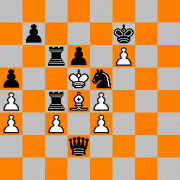 White to play
White to play
6 year old kid - 8 year old kid
Oslo, 2006
An unusual stalemate - the stalemated side has a force of 9 units. That raises the question what the maximum stalemated force might be. In my 2,1 million game database, I only found one game surpassing 8 - but by a large margin:
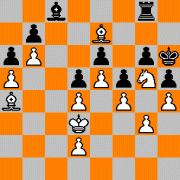 Black to play
Black to play
El Idrissi - Laaroussi
Rabat, ch Morocco, 2001
There followed: 49...Bd7 50.Bxd7 Rg7 51.Bf8?? stalemate. 12 units.
PS 21 December: Noam Elkies points to this stalemate from a game of the founding father of the modern endgame study.
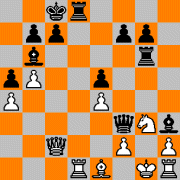 White to play
White to play
Troitzky - Vogt
Petersburg 1896
White drew with 1.Rxd8+ Kxd8 2.Qd1+ Qxd1 stalemate. He has sixteen units in the final position - perhaps I should have explained that by 'unit', I meant the usual counting unit of chess, the pawn (Q=9, R=5, etc.)
A few readers mentioned this very well-known composed game, where the entire white army (39 units) is stalemated.
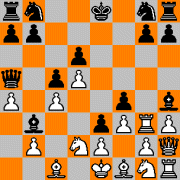 1.a4 c5 2.d4 d6 3.Qd2 e5 4.Qf4 e4 5.h3 Be7 6.Qh2 Bh4 7.Ra3 Be6 8.Rg3 Bb3 9.Nd2 Qa5 10.d5 e3 11.c4 f5 12.f3 f4
1.a4 c5 2.d4 d6 3.Qd2 e5 4.Qf4 e4 5.h3 Be7 6.Qh2 Bh4 7.Ra3 Be6 8.Rg3 Bb3 9.Nd2 Qa5 10.d5 e3 11.c4 f5 12.f3 f4
It is almost always given as a composition by Loyd, but in fact it is by Wheeler, Sunny South, 1887, as I found out in Edward Winter's Chess Notes. Almost twenty years later, Sam Loyd published a version of this game (1.d4 d6 2.Qd2 e5 3.a4 e4 4.Qf4 f5 5.h3 Be7 6.Qh2 Be6 7.Ra3 c5 8.Rg3 Qa5+ 9.Nd2 Bh4 10.f3 Bb3 11.d5 e3 12.c4 f4 stalemate) in the popular Lasker's Chess Magazine, as a spoof of Steinitz' analyses. That version became famous.
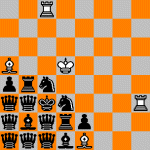 PS 12 March 2007: Andrew Buchanan send this legal position where a maximum force of 87 units is stalemated.
PS 12 March 2007: Andrew Buchanan send this legal position where a maximum force of 87 units is stalemated.
Johan Hut showed me an interesting game from the semifinals for the Dutch Championship. The winner is 16-year old Wouter Spoelman, one of the great hopefuls of Dutch chess.
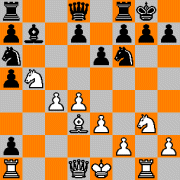 De Boer - Spoelman, Hilversum 2006
De Boer - Spoelman, Hilversum 2006
1.d4 Nf6 2.c4 e6 3.Nc3 Bb4 4.e3 b6 5.Nge2 c5 6.a3 Ba5 7.Rb1 Na6 8.Bd2 Bb7 9.Ng3 O-O 10.Bd3 Bxg2 11.Rg1 Bb7 12.b4 cxb4 13.Nb5 bxa3 14.Bxa5 a2 15.Ra1 bxa5 (see diagram) 16.c5 Nb4 17.Nd6 Nxd3+ 18.Qxd3 Qb8 19.e4 Ba6 20.Qc3 a4 21.Kd2 Qb3 22.Rgc1 Ng4 23.Rc2 Nxh2 24.Ke3 Rab8 25.Raxa2 f5 26.f4 Ng4+ 27.Kf3 Bd3 and White resigned.
Hut wondered if this could be fastest triplet on an edge-file. It wasn't; I found at least a dozen cases, all in the same variation, where this a-triplet had occurred before move 15. But the record turned out to have been achieved on the other side of the board.
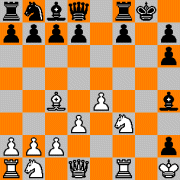 White to play
White to play
This position arose after Black's 9th move in two games: Miotto - Schild, Caorle open 1988 and Walrath - Higgins, Chicago Open 2002 - the second game with the Pd3 on d4, White having played 8.d4
1.e4 e5 2.f4 exf4 3.Nf3 Be7 4.Bc4 Bh4+ 5.g3 fxg3 6.O-O gxh2+ 7.Kh1 Nh6 8.d3 (Walrath played 8.d4) 8...O-O 9.Bxh6 gxh6
Miotto - Schild continued: 10.Ne5 Qe7 11.Qh5 Qg5 12.Bxf7+ Kg7 13.Nc3 Qxh5 14.Bxh5 Bf6 15.Ng4 Bxc3 16.Rxf8 Kxf8 17.Rf1+ Ke7 18.bxc3 d6 19.Rf7+ Kd8 20.Rf8+ Kd7 21.Nf6+ Ke7 22.Rf7+ Kd8 23.Nd5 Be6 24.Rf8+ and Black resigned.
And Walrath - Higgins: 10.Ne5 Kg7 11.Nxf7 Qe7 12.Nc3 d6 13.Qh5 Bg5 14.Nxg5 and Black resigned.
PS 4 January 2007: Joes Segal mentions a game Larsen - Lauridsen, Hostelbro/Herning 1948 which he saw in the Bent Larsen file at chessgames.com, which also ties this record. Up to 10.Ne5 it is the same as Walrath - Higgins, and then concludes with 10...Qe7 11.Nc3 c6 12.Bxf7+ Kg7 13.Bh5 Rxf1+ 14.Qxf1 d6 15.Nf3 Bg5 16.Qf2 Be6 17.d5 cxd5 18.exd5 Bf7 19.Nxg5 hxg5 20.Re1 Qf6 21.Qxf6+ Kxf6 22.Rf1+ Kg7 23.Bxf7 Nd7 24.Be6 and Black resigned.
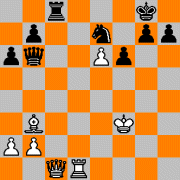 White to play
White to play
Zabaznov - Shevaldov
Ust-Labinsk, 2006
1.Qxc8+ Nxc8 2.Rd8+ Qxd8 3.e7+ Black resigned.
A pretty combination with an extra: the game had started with 1.e4, and was finished by that same pawn - that would also have been the case after 3...Qd5+ 4.Bxd5+ Kh8 5.e8Q mate.
Zabaznov wondered if there are other games with this phenomenon. I have to disappoint him - there must be thousands. The following game alone, the famous Albin's Counter Gambit trap, must have been played hundreds of times: 1.d4 d5 2.c4 e5 3.dxe5 d4 4.e3 Bb4+ 5.Bd2 dxe3 6.Bxb4 exf2+ 7.Ke2 fxg1N+ when the 1...d5 pawn has reached g1, and White often resigns. Even quicker, and with a Knight instead of a Pawn as the thematic piece, is the equally famous "Shortest Master game" 1.d4 Nf6 2.Nd2 e5 3.dxe5 Ng4 4.h3?? Ne3 (0-1) That game was never actually played, (see here), but many (longer) variations of it were.
I also found this grandmaster game.
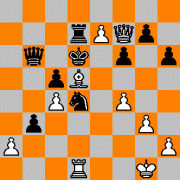 White to play
White to play
Kurajica - Franklin
Hastings 1971
"Everything" wins, but 41.e8N was mate - with the pawn of 1.e4.
332. 14 December 2006:
A picture postcard mate
One of the reasons I like Chess Today, is that they have a keen eye for the bizarre. Their new contributor, Alexey Deviatkin, is no exception. Yesterday (see item 331 below) I showed his discovery of a strange Queen's ending - one issue before that, he had found a picture postcard mate in his analysis of a game from the Russian championship.
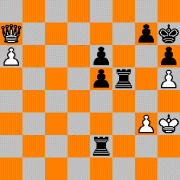 White to play
White to play
Najer - Jakovenko
Russian Championship, Moscow 12 December 2006
After 43.Qb8? White quickly lost: 43...Rxh5+ 44.Kg4 Re4+ 45.Kf3 Ra4 The possibility e4+ 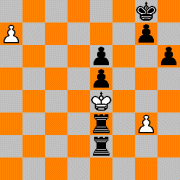 now wins the a-pawn. 46.Qb6 e4+ 47.Ke3 Rha5 48.Qxe6 Rxa6 49.Qf5+ Rg6 50.g4 Ra3+ and White resigned.
now wins the a-pawn. 46.Qb6 e4+ 47.Ke3 Rha5 48.Qxe6 Rxa6 49.Qf5+ Rg6 50.g4 Ra3+ and White resigned.
Deviatkin gave some very nice variations after (in the diagram)
43.Qb7, which seems to save White: 43...Rxh5+ 44.Kg4 Rf5 (Theatening Rh2 and h5 mate) 45.Kh3 Rff2 46.Qb1+ (Not 46.a7 Rh2+ 47.Kg4 Ref2 48.a8Q h5+ 49.Kg5 Rf5 mate) 46...Kg8 47.a7 Ra2 and now 48.Qb5 draws, but 48.Qb6 loses: 48... Rh2+ 49.Kg4 Ra4+ 50.Kf3 Ra3+ 51.Ke4 (or 51.Kg4 h5+ 52.Kg5 Rxg3 mate) 51...Re2+ 52.Qe3 Raxe3 mate - see diagram.
Not surprisingly, this mate almost never happens in practice, if only because mate seldom happens. And when it does, it's never as interesting as Deviatkin's find. Nevertheless, two examples.
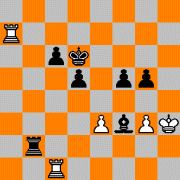
White to play
Kopylov - Berelovich
Internet blitz, 2005
This is even a standard combination - I found 3 or 4 examples with this setting. Black threatens Bg4 mate, and White could only have stayed alive a little longer with Ra4. After 39.g4 fxg4+ 40.Kg3 Rg2, it was mate.
|
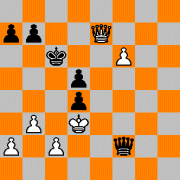
Black to play
Weeramantry - Khatena
USA open, 1990
A different form of the mate, as a blunder. White had been trying to win this ending for some 15 moves, and after 46...Qg1, he apparently thought he finally did. But: 47.f7? Qd1 mate.
|
I did find a very nice endgame study with this mate.
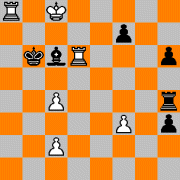 White to play and win
White to play and win
A. Wotawa
Österreichische Schachzeitung, 1953
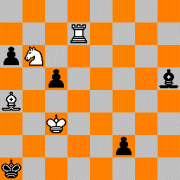 1.Ra1 Kc5 2.Rf6 h2 3.Rh1 Rh3 4.Rxf7 Bxf3 5.Rxf3 Rxf3 is only a draw, but how else is White going to stop the h-pawn and win? 1.Ra4! Threatening c5+ - 1...Rh5 fails to
2.Rxc6+ Kxc6 3.Ra6+ Kc5 and 4.Ra5+ 1...Kc5 2.Rxc6+ Kxc6 3.c3 After this quiet move, Black is helpless. 3...Kd(b)6 fails to 4.c5+; 3...Kc5 to 4.Kc7, and 3...Rh5 to 4.Ra6+ and 5.Ra5+ 3...h2 There is nothing else 4.Ra6+ Kc5 5.Kc7 h1Q Or 5...Rxc4 6.Ra5 mate, or 5...Kxc4 6.Ra4+ etc. 6.Rc6 and Deviatkin's mate materializes - see diagram.
1.Ra1 Kc5 2.Rf6 h2 3.Rh1 Rh3 4.Rxf7 Bxf3 5.Rxf3 Rxf3 is only a draw, but how else is White going to stop the h-pawn and win? 1.Ra4! Threatening c5+ - 1...Rh5 fails to
2.Rxc6+ Kxc6 3.Ra6+ Kc5 and 4.Ra5+ 1...Kc5 2.Rxc6+ Kxc6 3.c3 After this quiet move, Black is helpless. 3...Kd(b)6 fails to 4.c5+; 3...Kc5 to 4.Kc7, and 3...Rh5 to 4.Ra6+ and 5.Ra5+ 3...h2 There is nothing else 4.Ra6+ Kc5 5.Kc7 h1Q Or 5...Rxc4 6.Ra5 mate, or 5...Kxc4 6.Ra4+ etc. 6.Rc6 and Deviatkin's mate materializes - see diagram.
PS 18 December: If we generalize a little further, we find that the oldest example of, why not, Deviatkin's mate, might be 99 years old.
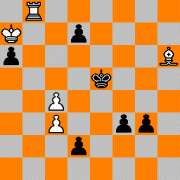 White to play and win
White to play and win
H. Rinck
Deutsche Schachzeitung 1908
1.Bxd2 f2 2.Be1! f1Q 3.Re8+ Kd6 4.Bxg3+ Kc5 5.Rc8 mate.
Another very pretty one:
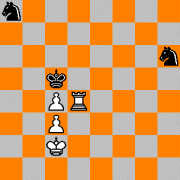 White to play and win
White to play and win
S. Kaminer
Leningradskaja Pravda 1927
1.Rh4 Nf7 2.Rh7 Nd6 or 2...Ne5 3.Ra7 Nb6 4.Ra5+ Kd6 5.c5+ 3.Ra7 Nb6 4.Rc7 mate.
In games, it is remarkably often allowed by a blunder.
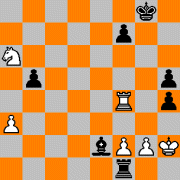 White to play
White to play
Larrat - Shirazi
Paris Open, 2001
White wanted to get the h-pawn with his King. But: 41.Kh3?? Rh1 mate.
331. 13 December 2006:
Being a pawn up in a Queen's ending
In today's Chess Today, Andrey Deviatkin gave the following "amusing" endgame.
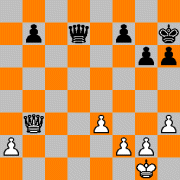 White to play
White to play
Bonin (2310) - Sarkar (2380)
Marshall Club Championship, New York, 9 December 2006
White is a pawn up, and tries to win.
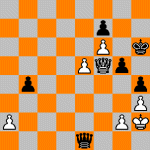 After 32.e4 Kg7 33.Qc3+ Kg8 34.f4 Qe6 35.Qc2 Qb6+ 36.Kh1 Qe3 37.f5 g5 38.f6 h5 39.Qc8+ Kh7 40.Qf5+ Kh6 41.Kh2 h4 42.e5 b5 43.Kh1 Qe1+ 44.Kh2 b4 the diagram on the right came about, of which Deviatkin writes: "An absolutely unique position, which I have never seen! For the first look White seems to dominate. Moreover, Black is a pawn down. But White doesn't have good moves, and he loses!
After 32.e4 Kg7 33.Qc3+ Kg8 34.f4 Qe6 35.Qc2 Qb6+ 36.Kh1 Qe3 37.f5 g5 38.f6 h5 39.Qc8+ Kh7 40.Qf5+ Kh6 41.Kh2 h4 42.e5 b5 43.Kh1 Qe1+ 44.Kh2 b4 the diagram on the right came about, of which Deviatkin writes: "An absolutely unique position, which I have never seen! For the first look White seems to dominate. Moreover, Black is a pawn down. But White doesn't have good moves, and he loses!
Maybe Bonin could defend better then, but he
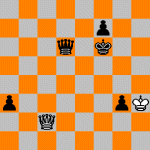 was probably demoralized and couldn't resist persistently." There followed: 45.e6 Qxe6 46.Qb1 Qd6+ 47.Kh1 Qf4 48.Kg1 g4 49.hxg4 Qxg4 50.Qb3 Kg6 51.a3 Qd4+ 52.Kh2 Qd6+ 53.Kh3 bxa3
54.Qc2+ Kg5 55.Qc1+ Kh5 56.g4+ hxg3 57.Qc8 Kg6 58.Qc2+ Kxf6 (see diagram) and White resigned; instead of one pawn up, he is now three pawns down.
was probably demoralized and couldn't resist persistently." There followed: 45.e6 Qxe6 46.Qb1 Qd6+ 47.Kh1 Qf4 48.Kg1 g4 49.hxg4 Qxg4 50.Qb3 Kg6 51.a3 Qd4+ 52.Kh2 Qd6+ 53.Kh3 bxa3
54.Qc2+ Kg5 55.Qc1+ Kh5 56.g4+ hxg3 57.Qc8 Kg6 58.Qc2+ Kxf6 (see diagram) and White resigned; instead of one pawn up, he is now three pawns down.
"Absolutely unique" - but it did remind me of this case.
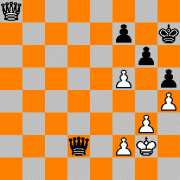 White to play
White to play
Larsen - Keres
San Antonio 1972
In a vaguely similar situation, White is a pawn up, although with even smaller, not to say nonexistant, chances of winning. But Larsen's fighting spirit was proverbial. 44.Qb7 Kg8 45.f6 Qd8 46.Qc6 Kh7 47.Qc3 Qd5+ 48.f3 Qa2+ 49.Kh3 Qb1 50.Kg2 Qa2+ 51.Kf1 Qa6+ 52.Ke1 Qe6+ 53.Kf2 Qa2+ 54.Kg1 Qb1+ 55.Kg2 Qa2+ It's the third time this position arises, but 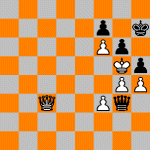 strangely, Keres doesn't claim a draw. Did he have an inkling of what Larsen was going to do to himself? 56.Kh3 Qb1 57.g4 And indeed, Larsen starts to compose a fatal Zugzwang. 57...Qh1+ 58.Kg3 Qg1+ 59.Kf4 Qh2+ 60.Kg5 Ke4 or Ke3 should still be a draw. 60...Qg3 (see diagram on the right) 61.Qe3 The only move. After 61.Qd4 Qxf3, or 61.Qc5 Qxf3 62.Qd4 Qe2 White is in a losing bind. 61...hxg4 62.Qf4 Qxf3 63.Qxg4 Qe3+ 64.Qf4 Qe2 The mating threat costs White his f6-pawn, too. Perhaps Larsen could still have
strangely, Keres doesn't claim a draw. Did he have an inkling of what Larsen was going to do to himself? 56.Kh3 Qb1 57.g4 And indeed, Larsen starts to compose a fatal Zugzwang. 57...Qh1+ 58.Kg3 Qg1+ 59.Kf4 Qh2+ 60.Kg5 Ke4 or Ke3 should still be a draw. 60...Qg3 (see diagram on the right) 61.Qe3 The only move. After 61.Qd4 Qxf3, or 61.Qc5 Qxf3 62.Qd4 Qe2 White is in a losing bind. 61...hxg4 62.Qf4 Qxf3 63.Qxg4 Qe3+ 64.Qf4 Qe2 The mating threat costs White his f6-pawn, too. Perhaps Larsen could still have
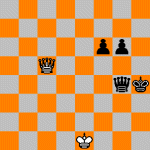 drawn, but he must have been too dejected to really try. 65.Qg3 Qb5+ 66.Kf4 Qf5+ 67.Ke3 Qxf6 68.Qg5 Qf1 69.Qg4 Qe1+ 70.Kd3 Qe6 71.Qf4 Kg7 72.Qd4+ f6 73.Qb4 Qf5+ 74.Ke2 Kh6 75.Ke1 Kh5 76.Qc4 Qg4 77.Qc5+ Kxh4 (see diagram) Instead of one pawn up, White is now two pawns down. 78.Qe7 Qf5 79.Qb4+ Kh5 80.Qc4 g5 81.Qf7+ Kh4 82.Qf8 Kg3 83.Qa3+ Qf3 84.Qd6+ Kg2 85.Qd2+ Kh3 86.Qd7+ f5 87.Qg7 g4 88.Qh8+ Kg3 89.Qe5+ f4 90.Qb8 Qe3+ 91.Kd1 Kg2 and White resigned.
drawn, but he must have been too dejected to really try. 65.Qg3 Qb5+ 66.Kf4 Qf5+ 67.Ke3 Qxf6 68.Qg5 Qf1 69.Qg4 Qe1+ 70.Kd3 Qe6 71.Qf4 Kg7 72.Qd4+ f6 73.Qb4 Qf5+ 74.Ke2 Kh6 75.Ke1 Kh5 76.Qc4 Qg4 77.Qc5+ Kxh4 (see diagram) Instead of one pawn up, White is now two pawns down. 78.Qe7 Qf5 79.Qb4+ Kh5 80.Qc4 g5 81.Qf7+ Kh4 82.Qf8 Kg3 83.Qa3+ Qf3 84.Qd6+ Kg2 85.Qd2+ Kh3 86.Qd7+ f5 87.Qg7 g4 88.Qh8+ Kg3 89.Qe5+ f4 90.Qb8 Qe3+ 91.Kd1 Kg2 and White resigned.
330. 1 December 2006:
Fritz 10 allows mate in 1, too
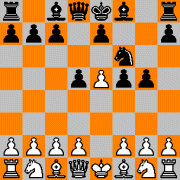 Black to play
Black to play
In this position, Fritz 10, lauded by its vendor Chessbase as "the worlds finest chess playing program" and "one of the most powerful chess playing entities on the planet", and whose multiprocessor version "Deep Fritz" is now playing Kramnik, plays 10...Nd7, inviting a mate in 1 that isn't even threatened. It does so in its strongest mode, "infinite analysis". In fact, when I asked Fritz 10 for a "Hint" in this position, it said "The silicon entity strongly suggests Nf6-d7" and evaluated the resulting position as = (0.00), even if Black, if we forget about mate for a second, is a piece down.
Before you set up the position to see whether your Fritz 10 also strongly thinks it can equalize with Nf6-d7, I should explain how I arrived at this position, and how Fritz 10 arrives at this move.
In item 328 below, about a 283-move game between the computer programs Hiarcs and Rybka, I said that "both programs did know all the rules". This prompted an interesting reaction by Wijnand Engelkes, a fellow-computerchess debunker. "After half a century of computer chess," he wrote, "this [programs knowing the Laws of Chess] sadly has not yet been achieved." He illustrated this with the following game that he had fed into Rybka 2.2, "the strongest
computerprogram in the world".
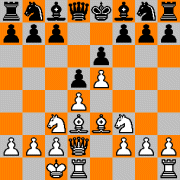 Black to play
Black to play
1.Nf3 e6 2.Nc3 Qe7 3.e4 Qd8 4.d4 Qe7 5.Be3 Qd8 6.Bd3 Qe7 7.Qd2 Qd8 8.e5 Qh4 9.O-O-O d5 10.Ng1 Qd8 11.Nf3 Qh4 12.Ng1 Qd8 13.Nf3 (see diagram) after which Rybka, left to its own devices, plays 13...Qh4, claiming a draw on the grounds of the three-fold repetition rule. An incorrect claim, because although the diagram arises for the third time - the position does so only for the second time, as White's option of en passant capturing, which he had after 9...d5, has vanished - see article 9.2, FIDE Laws of Chess.
When I tried this game with Fritz 10, its ignorance of the repetition rules turned out to be even worse. After 12.Ng1, it suggests 12...Qd8, adding "= (0.00)" when that position, not even considering en passant rights, would arise just for the second time. Asked for a hint in the diagram, Fritz 10 says: "I simply cannot find any alternative to Qh4."
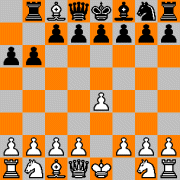 Engelkes also gave a little game to test the program's knowledge of article 9.2 regarding castling rights: 1.e4 Na6 2.Bxa6 b6 3.Bxc8 A prelude to make Black draw-hungry. 3...a6 4.Bb7 Rb8 5.Bc8 Ra8 Perhaps it is not so strange that Rybka, a new program, hasn't yet implemented the intricacies of existing and vanishing castling and en passant rights, but it is strange that Fritz 10 now considers 6.Bxa6 and Bxd7+ as White's strongest moves, closely followed by Nf3 and Nc3 - apparently because it's afraid that after 6.Bb7 Black would play 6...Rb8 with the dreaded = (0.00). But that position would be entirely new. After 7.Bc8 (see diagram) Fritz 10's behavior becomes looney. Asked for a Hint for Black, it says "Your pawn is not defended. You must hurry to its support." And when you press the Suggestion button: "Black has to go for Ra8." An incorrect repetition claim, explained as the guarding of a pawn - when he could simply capture the attacking piece.
Engelkes also gave a little game to test the program's knowledge of article 9.2 regarding castling rights: 1.e4 Na6 2.Bxa6 b6 3.Bxc8 A prelude to make Black draw-hungry. 3...a6 4.Bb7 Rb8 5.Bc8 Ra8 Perhaps it is not so strange that Rybka, a new program, hasn't yet implemented the intricacies of existing and vanishing castling and en passant rights, but it is strange that Fritz 10 now considers 6.Bxa6 and Bxd7+ as White's strongest moves, closely followed by Nf3 and Nc3 - apparently because it's afraid that after 6.Bb7 Black would play 6...Rb8 with the dreaded = (0.00). But that position would be entirely new. After 7.Bc8 (see diagram) Fritz 10's behavior becomes looney. Asked for a Hint for Black, it says "Your pawn is not defended. You must hurry to its support." And when you press the Suggestion button: "Black has to go for Ra8." An incorrect repetition claim, explained as the guarding of a pawn - when he could simply capture the attacking piece.
Wondering if its ignorance of the repetition rule would lead Fritz, like Kramnik, to even allow mate in 1, I constructed a game that leads to the first diagram.
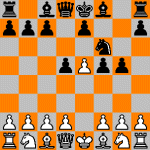 1.e4 Na6 2.Bxa6 d5 3.Bf1 Engelkes' idea, to make Black eager for a draw 3...g5 4.Qh5 Nf6 5.Qd1 Fritz 10 very prematurely gives 5...Ng8 as = (0.00) - that would only be the first repetition 5...Nd7 6.e5 f5 7.Qe2 Nf6 8.Qd1 Nd7 9.Qe2 "Your best move is Nf6, Tim" - but that wouldn't achieve a threefold repetition at all - it just hangs a Knight. 9...Nf6 10.Qd1 And we're back in the first diagram, now on the right. 10...Nd7 11.Qe2 Nf6 12.Qd1 Fritz 10's infinite analysis again gives Nd7 with equality, but if I click for a hint now, it says, correctly at last: "Threefold repetition" and "Game finished."
1.e4 Na6 2.Bxa6 d5 3.Bf1 Engelkes' idea, to make Black eager for a draw 3...g5 4.Qh5 Nf6 5.Qd1 Fritz 10 very prematurely gives 5...Ng8 as = (0.00) - that would only be the first repetition 5...Nd7 6.e5 f5 7.Qe2 Nf6 8.Qd1 Nd7 9.Qe2 "Your best move is Nf6, Tim" - but that wouldn't achieve a threefold repetition at all - it just hangs a Knight. 9...Nf6 10.Qd1 And we're back in the first diagram, now on the right. 10...Nd7 11.Qe2 Nf6 12.Qd1 Fritz 10's infinite analysis again gives Nd7 with equality, but if I click for a hint now, it says, correctly at last: "Threefold repetition" and "Game finished."
Engelkes: "Generally, programmers are very lazy and perfectionism is foreign to them. Why would you program something if it almost never happens and only weakens your program? A program should keep exact EPD-strings of all the positions it has encountered. Including castling and en passant options. Apparently, they do not do that. I guess it would cost them half a nanosecond for their evaluations."
PS 22 December: To which Noam Elkies replies:
"Probably the real cost would be not time but space: using a longer string to encode a position means that there is room for fewer positions in memory, which may very well make the program play measurably worse. There's also the issue that it would take rather more than a nanosecond, not to mention numerous nanoeuros, for the human programmers to implement
this, and - because humans can make mistakes - such an implementation has a nontrivial chance of containing a bug that would actually make the program make the occasional mysterious blunder in an actual game."
329. 30 November 2006:
The difficulty of seeing Qh7 mate
Kramnik overlooking mate in one, when there wasn't a trace of time trouble, will be the talk of the town for some time.
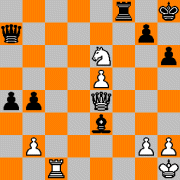 Black to play
Black to play
Deep Fritz - Kramnik
Bonn, 2006
There followed: 33...Bxc1 34.Nxf8 Qe3?? 35.Qh7 mate.
How could it happen? Kramnik himself doesn't know. In the press conference after the game, he said he had been calculating and recalculating the line for a long time. He was feeling well, it must have been some kind of blackout. "I cannot really find any explanation."
In a report at the ChessBase website, Alexander Roshal is quoted, saying that this "mating pattern (...), with the white queen protected by a knight on f8, is extremely rare in chess. It is not one of the patterns that chess grandmasters automatically have in their repertoire." This seems to be collaborated by a GM commentator in Bonn who also didn't see the mate, discussing White's options after Qe3.
I don't believe this explanation. A more logical one is that the Knight arrived on f8 for other reasons than to attack the King - it went there to capture the Rook. Also, that mating pattern is not extremely rare. It is even the conclusion of a standard combination, as in the following case.
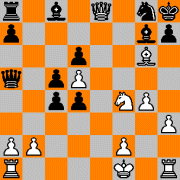
White to play
Perez Garcia - Zagema
Enschede 1995
21.Bxh7 Kxh7 22.Qe4+ Kh8 23.Ng6+ Kh7 24.Nf8+ Kh8 25.Qh7 mate.
Using Chess Query Language (see here or
here), I found this mating pattern, or rather the threat of it, in some 120 games. It is certainly strange that in no less than 5 of those cases, it was overlooked.
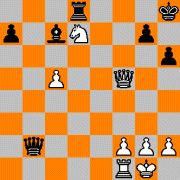 White to play
White to play
Vogelmann - Moerschbach
Germany 1990
After 35.Nf8 White was winning (Bxh2+ 36.Kh1), but it didn't have to be as quick as 35...Be5 36.Qh7 mate.
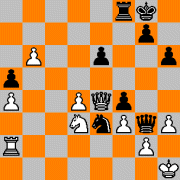 Black to play
Black to play
Pisk - Krsek
Moravka 1994
After 30...Nf1, all White had to do to win was Kg1 (or Qxe6+ first) but even with the Queen so close by, and, as in the previous example, no other possible reason for Nf1 than some threat against the King, White didn't see it: 31.b7?? Qh2 mate.
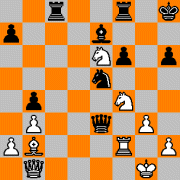 White to play
White to play
Scherer - Eg
Wiesbaden 1998
Like Kramnik, Black must have felt that 36.Nxf8 was played just for material reasons, so he thought he could play a materialistic move as well: 36...Bc5?? After recapturing, White would not be much better. But now: 37.Qh7 mate.
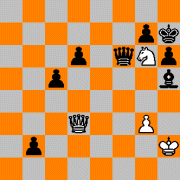 White to play
White to play
Tusu - Todoran
France 1998
This case is really incomprehensible: 45.Nf8+ Kh8?? 46.Qh7 mate.
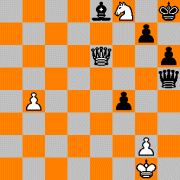 White to play
White to play
Bellini (2485) - Gashimov (2580)
Olympiad, Bled 2002
But this is the strangest example that I found. It is (apart from Fritz - Kramnik) not only the highest level at which the mate was missed - it was missed by both sides. There followed 50.Qe4 (attacking f4) 50...Qf7 (defending f4) 51.Ne6 (attacking f4 once more) and after some 20 more moves, the game ended in a draw.
One thing is certain: if Kramnik had known the famous problem below, it wouldn't have happened.
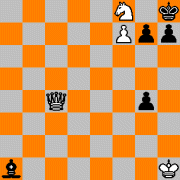 Mate in 3
Mate in 3
Sam Loyd
Leipziger Illustrierte Zeitung 1869
1.Qf1 and whatever Black plays, the Queen can always threaten mate on h7, while providing a mate against the defense g6, e.g. 1...Bb2 2.Qb1 g6 3.Qxb2 mate, or 1...h5 2.Qb1 g6 3.Qxa1 mate, or 1...Bf6 2.Qf5 g6 3.Qxf6 mate. Side variation: 1...g3 2.Ng6+ and Qh3 mate.
328. 26 November 2006:
A 283-move decisive computer game
Dann Corbit sent me a new record (but see PS!) in computer (or any) games: a 283-move decisive game.
The human record is still the 269-move draw
Nikolic - Arsovic, Belgrade 1989, but between computers, quite a few games of over 300 moves were already known, like NewRival1816 - Faile06, 2001. That game ended in a draw after 493 moves, of which the last 402 however, had been played with lone Kings on both sides. As Corbit remarks, in all of those 300+ games, the computers lacked some knowledge of the Laws of Chess, like the 3-fold repetition, or the 50-move rule.
But in the 283-move win for Black Hiarcs X54 - Rybka 1.2, recently played in a testing tournament, both programs did know all the rules. After some initial woodshifting, it even had an interesting finish.
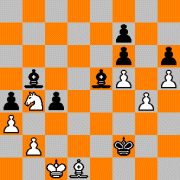 Black to play
Black to play
Hiarcs X54 - Rybka 1.2
CCRL, 2006
There followed 262...c3 263.b3 axb3 264.Bxb3 Ke3 265.a4 Be2 266.Bd1 Bf1 267.a5 Bd6 268.Nd5+ Kd4 269.Nxf6 Bf4+ 270.Kb1 Bg5 271.Nd7 Bb5 272.Nb6 Kd3 273.Nd5 Kd2 274.Bc2 Bd8 275.Nf4 Bc4 276.Nh3 Ke3 277.g5 hxg5 278.h6 g4 279.h7 Bf6 280.Ng5 g3 281.Kc1 Be2 282.a6 Bxa6 283.Bd1 Bd3 and White resigned.
The whole game can be played over on the left.
PS1 5 December: Guy Haworth rightly remarks that Hiarcs resigned (in a human sense) a bit prematurely, and that a continuation could have been interesting, and have reached the 300-move mark. One variation he gives: 284.Bc2 Be2 285.Bd1 Bxd1 286.Kxd1 Kd3 287.Nh3 c2+ 288.Kc1 Kc3 289.h8Q Bxh8 290.f6 Bxf6 291.Nf4 and now Black must not play Bg5 (stalemate) but 291...Kb3 with mate on the 299th move.
However, it turns out Hiarcs - Rybka wasn't the record at all - see PS2.
PS2 5 December: Uri Blass sent me 4 extremely long computer vs. computer games, all played in the WBEC testing tournaments, and all without offending any 50-move or threefold repetition rules.
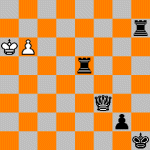 Position after 295.Ka6
Position after 295.Ka6
Jonny 2.82-x64 - Nejmet 3.07
WBEC, 2005
One of these games, Jonny 2.82-x64 - Nejmet, WBEC, 2005, which can be played over on the left, turns out to have preceded Hiarcs - Rybka by a year, and is 12 moves longer: this is the longest decisive game. White resigned in the diagram, after playing his 295th move. Like Hiarcs - Rybka, it was a non-trivial, rather interesting Q vs. R+R endgame. And here too, the loser resigned before a human would have done so . There could have followed something like 295...Rh6 296.Ka7 Ra5+ 297.Kb7 Rb5 298.Kc8 Rbxb6 299.Qe4 Rbg6 300.Kd8 Rg7 and White must allow mate or promotion - the 300-move mark would have been made.
Even longer could have been the strange Ufim 4.02 - Kaissa 1.7, WBEC, 2003, where White, who could mate in 4 at move 300, suddenly declared the game drawn, because of "too many moves". Too many for what - for ChessBase, which has a limit of 300 moves? This game too, was not uninteresting - see on the left. That is, if poor Palview doesn't crash under the burden of these mammoth games.
I'm not giving the 302 moves of Leila 0.53h - Cerebro 1.30, WBEC, 2005, where a dead-drawn opposite Bishops ending was reached at move 86. It continued, slimming very slowly in the process, until move 302 when it was still dead-drawn, but some bug in Cerebro suddenly halted it, causing the game to be scored 1-0.
I'm also not reproducing the 375-move draw Nejmet 3.07 - Gothmog 1.0b10, WBEC, 2004. After move 73 in that game, White was left with only a King, and Black with a King, two h-pawns, and a Bishop of the wrong color. Black pressed for a win, and to avoid the dangers of the 50-move rule, he had a pawn dutifully step forward every fifty moves - except for a mysterious interlude from move 122 to 124, when he made 3 pawn moves in a row. That threw away a hundred moves of the record for drawn computer vs. computer games, which would otherwise have been 475 moves.
We don't have to worry - the 500-move mark in computer vs. computer games will be passed soon enough.
327. 6 November 2006:
The mystery of Tylkowski - Wojciechowski
The two games below are strangest game-anticipation ever, or one of them is the best hoax.
Tylkowski - Wojciechowski, Poznan 1931
1.f4 d5 2.e3 c5 3.Nf3 Nc6 4.Bb5 Bg4 5.O-O e6 6.d3 Be7 7.Nc3 d4 8.Nb1 Nf6 9.e4 O-O 10.Bxc6 bxc6 11.c3 dxc3 12.Nxc3 Bxf3 13.Rxf3 Ng4 14.Kh1 Qd4 15.Qg1 Qxg1+ 16.Kxg1 Bd8 17.Be3 Nxe3 18.Rxe3 Bb6 19.Rd1 h6 20.e5 f6 21.exf6 Rxf6 22.Rf3 c4+ 23.d4 c5 24.d5 exd5 25.Rxd5 Kh7 26.Rd7 Rd8 27.Rb7 Rg6 28.Rg3 Rxg3 29.hxg3 Rd2 30.Na4
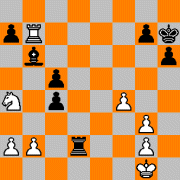
30...Rxb2 31.Nxb2 c3 32.Rxb6 c4 33.Rb4 a5 34.Nxc4 c2 35.Nxa5 c1Q+ 36.Kh2 Qc5 37.Rb2 Qxa5 38.g4 Qe1 39.g3 h5 40.gxh5 Kh6 and White resigned.
|
Ortueta - Sanz, Madrid 1933
1.e4 e6 2.d3 d5 3.Nc3 Nf6 4.e5 Nfd7 5.f4 Bb4 6.Bd2 O-O 7.Nf3 f6 8.d4 c5 9.Nb5 fxe5 10.dxe5 Rxf4 11.c3 Re4+ 12.Be2 Ba5 13.O-O Nxe5 14.Nxe5 Rxe5 15.Bf4 Rf5 16.Bd3 Rf6 17.Qc2 h6 18.Be5 Nd7 19.Bxf6 Nxf6 20.Rxf6 Qxf6 21.Rf1 Qe7 22.Bh7+ Kh8 23.Qg6 Bd7 24.Rf7 Qg5 25.Qxg5 hxg5 26.Rxd7 Kxh7 27.Rxb7 Bb6 28.c4 dxc4 29.Nc3 Rd8 30.h3 Rd2 31.Na4
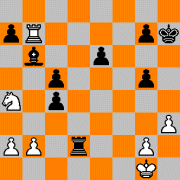
31...Rxb2 32.Nxb2 c3 33.Rxb6 c4 34.Rb4 a5 35.Nxc4 c2 and White resigned
|
I wrote about this case
elsewhere on this site, but the gist is this.
Ortueta-Sanz was already famous, when in the 50ties, the earlier Tylkowski - Wojciechowski surfaced in the Polish magazine Szachy. Irving Chernev published it in his 1974 Wonders and Curiosities of Chess and when I researched it in 1977 and again in 1998 with the help of the Polish chess historian Tomasz Lissowski, I discovered that quite a few chess players doubted the authenticity of the Polish Rxb2 game, and that these doubts had already existed in Poland itself, when the game was first unearthed. Different witnesses remembered different things: some had actually seen it played; others
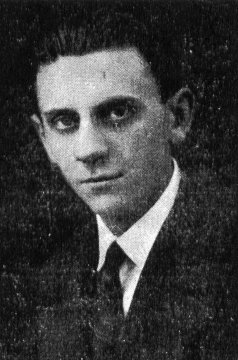
Antoni Wojciechowski, 1908-1938
|
had seen (a copy of) the game score; still others had seen the combination in the chess column of the local paper, the Dziennik Poznanski. Some believed the game to have been played in the Poznan city championship of 1931, others thought it might have been a private game, still others thought it might never have been played at all. I offered a fortune (one of my chess books) to anyone who could show me the chess column in question.
Alas, no fortune for him, endgame study guru Harold van der Heijden wrote me recently. Scavenging for unknown studies, he had been searching the
Dziennik Poznanski from 1927 to 1933, which now turns out to be online. Except for just 4 issues, he was able to browse the whole period, and he did not find the mythological column with Tylkowski - Wojciechowski. He did find crosstables of a few Poznan championships, with Tylkowski and Wojciechowski as participants, but either W. did not win their encounter, or he did (in 1929), but the game which was given, was a different one.
It seems certain, then, that the Rxb2-game Tylkowski - Wojciechowski was not played in a Poznan championship, and was not published in the Dziennik Poznanski. Of course that does not prove that this game was never played, and I'm still convinced that it was. It is hard to think of a reason why it would have been invented, and it would have been extremely hard to invent it. Both games seem genuine.
This Tylkowski - Wojciechowski was probably a free game between the two top Poznan players, and when the beautiful combination occurred, it was shown around by them and by others, creating myths, false memories and confusion along the way.
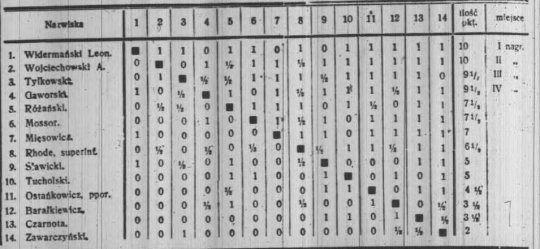
Crosstable of the 1931 Poznan Championship
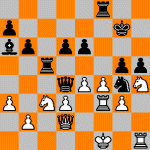 Tylkowski - Wojciechowski, Poznan 1929
Tylkowski - Wojciechowski, Poznan 1929
1.d4 Nf6 2.Nf3 b6 3.Nc3 Bb7 4.d5 g6 5.e4 d6 6.h3 Bg7 7.Be3 O-O 8.Qd2 c6 9.dxc6 Nxc6 10.Bd3 Rc8 11.Bh6 Nb4 12.a3 Nxd3+ 13.cxd3 Re8 14.h4 e6 15.h5 Ba6 16.hxg6 fxg6 17.Bxg7 Kxg7 18.Ke2 h5 19.Nh4 Ng4 20.f4 Qf6 21.Raf1 Rf8 22.Rf3 Rc5 23.g3 Qd4 24.Kf1 g5 (see diagram) 25.Ng2 Ne5 26.fxe5 Rxf3+ 27.Ke1 Rxe5 28.Qe2 g4 29.a4 Bxd3 30.Qd2 Rxg3 31.Ne2 Qxe4 and White resigned.
326. 31 October 2006:
Fischer's Zwickmühle
Earlier this month, it was 50 years ago that the "Game of the Century" was played.
Donald Byrne - Fischer, New York, 18 October 1956
The game became famous for the Queen's sac, Fischer's age of 13, and the move 11...Na4! - but what I've always liked best about it, is the finishing touch.
1.Nf3 Nf6 2.c4 g6 3.Nc3 Bg7 4.d4 O-O 5.Bf4 d5 6.Qb3 dxc4 7.Qxc4 c6 8.e4 Nbd7 9.Rd1 Nb6 10.Qc5 Bg4 11.Bg5 Na4 12.Qa3 Nxc3 13.bxc3 Nxe4 14.Bxe7 Qb6 15.Bc4 Nxc3 16.Bc5 Rfe8+ 17.Kf1 Be6 18.Bxb6 Bxc4+ 19.Kg1
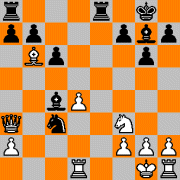
Position after 19.Kg1
|
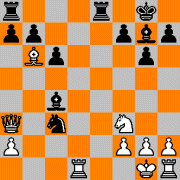
Position after 23.Kg1
|
19...Ne2+ 20.Kf1 Nxd4+ 21.Kg1 Ne2+ 22.Kf1 Nc3+ 23.Kg1 and only now, when Black has used a Zwickmühle to remove the Pd4 and guard his Nc3: 19...axb6 There followed 24.Qb4 Ra4 25.Qxb6 Nxd1 26.h3 Rxa2 27.Kh2 Nxf2 28.Re1 Rxe1 29.Qd8+ Bf8 30.Nxe1 Bd5 31.Nf3 Ne4 32.Qb8 b5 33.h4 h5 34.Ne5 Kg7 35.Kg1 Bc5+ 36.Kf1 Ng3+ 37.Ke1 Bb4+ 38.Kd1 Bb3+ 39.Kc1 Ne2+ 40.Kb1 Nc3+ 41.Kc1 Rc2 mate.
In games, the Zwickmühle is almost exclusively used to remove material for its own sake - the precise and clear, Fischer-like strategic use of it here, is rare. I found a few other cases, where a position is repeated after a Zwickmühle has removed of some material. In most of them, as in Byrne - Fischer, the enemy piece is removed to clear a line.
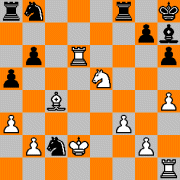 White to play
White to play
Soln - Schroeder
Rimavska Sobota, 1992
White had several ways to win, but 25.Nf7+ Kg8 26.Nxh6+ Kh8 27.Nf7+ Kg8 28.Ne5+ Kh8 was the nicest - the position is repeated, except for the vanished Ph6. Now 29.h5 carries the deadly threat of Ng6+ After 29...Bg8 30.Ng6+ Kh7 31.Nxf8+, Black resigned.
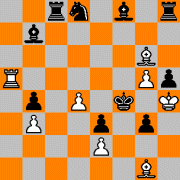
Mate in 10
J. Vladimirov, 1973
Here, a line must be cleared for a pawn. White wants to play 1.Rf5+ Ke4 2.Rf6+ Kd5 3.e4 mate, so it would be nice if the Pe3 wasn't there. 1.Re5 (1.Bb1? Bc5 or Rc5!) 1...Rc3 2.Bb1 Bc8 and the Zwickmühle, upside down now, and removes the obstacle: 3.Re4+ Kf5 4.Rxe3+ Kf4 5.Re4+ Kf5 6.Re5+ Kf4 7.Bg6 threatening Re4 mate. 7...Bb7 (or 7...Bf5 8.Rxf5+ Ke4 9.Rf6+ Kd5 10.e4 mate) and the position after 1...Rc3 is repeated, minus the Pe3. So: 8.Rf5+ Ke4 9.Rf6+ Kd5 10.e4 mate.
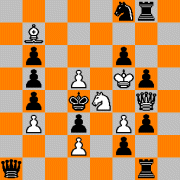 Mate in 6
Mate in 6
V. Zipf & H. Klug
3e place WCCT 1975
After 1.Bc6, the threat is Nd6+ and Nb7 mate. Black has two defences:
a) 1...Qa6 This weakens g1: 2.Nxf2+ Kc5 3.Ne4+ Kd4 4.Nxg3+ Kc5 5.Ne4+ Kd4 6.Qxg1 mate.
b) 1...Rg7 And this weakens g7: 2.Nxf6+ Kc5 3.Ne4+ Kd4 4.Nxg5+ Kc5 5.Ne4+ Kd4 6.Qxg7 mate.
A double double setting of the theme - in two variations, the Zwickmühle repeats the position, after making two pawns disappear: one vanishing clears the mating line, after which the other clears the Queen's line to the mating square.
In item 270 in this Diary, I already gave a wonderful 29-mover by M. Kwiatkowski, where different reasons for removal-by-Zwickmühle were combined - here is one more.
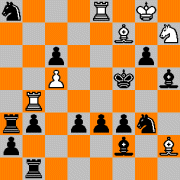 Mate in 9
Mate in 9
H. Grasemann
1st Prize Schach 1956
White would like to play 1.Rbe4 Nxe4 2.Be6 mate, but 1...a1Q spoils this. A Zwickmühle can remove the inconvenient pawn, but after 1.Be6+ Ke5 2.Bxb3+ Kf5 3.Be6+ Ke5 4.Bxa2+ Kf5 5.Be6+ Ke5 6.Bf7+ Kf5 7.Rbe4 Rb8! the vanishing of the Pb3 turns out not only to have cleared White's path to a2, but also Black's path to b8. Therefore: 1.Bc4, threatening 2.Bxd3+ and mate. 1...Rd1 Or 1...b2 2.Be6+ Ke5 3.Bf7+ Kf5 4.Rbe4 and mate, or 1...a1Q 2.Bxd3+ Ne4 3.Bxe4+ Kg4 4.Bf5+ Kxf5 5.Rf4 mate. But now: 2.Be6+ Ke5 3.Bxb3+ Kf5 4.Be6+ Ke5 5.Bxa2+ Kf5 6.Be6+ Ke5 7.Bf7+ Kf5 And the initial position is repeated without the two black pawns - OK, and with the Rb1 at d1. 8.Rbe4 Nxe4 9.Be6 mate, or 8...Rd2 9.R8e5 mate.
Another reason for removing enemy material can be to unblock a square that is needed for a pawn move.
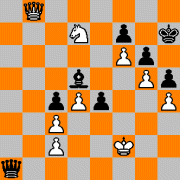 White to play
White to play
Toth - Szokacs
Salgotarjan 1977
After 32.Qf8 e3+ the black Queen would come into play. But after 32.Nf8+ Kg8 33.Nxg6+ Kh7 34.Nf8+ Kh8 35.Nd7+ Kh7, removing the Pg6, and vacating that square, White had 36.g6+, mating soon; after 36...fxg6 37.Nf8+ Kh8 38.Ne6+ Black resigned; he is mated.
Not a very pure example, as 35.Ne6+ is just as good - the Pg6-less repetition is not necessary.
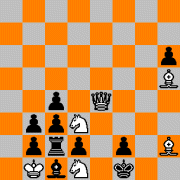 Selfmate in 6
Selfmate in 6
V. Pachman, 1979
In this witty selfmate, the Zwickmühle empties and unblocks a mating square in two variations.
After 1.Bf3, Black has two moves.
a) 1...cxd3 2.Ne3+ Ke1 3.Nxc2+ Kf1 4.Ne3+ Ke1 5.Nd1+ Kf1 and we're back in the position after 1...cxd3, but without the Rc2. Which means that after 6.Bh5 Black only has 6...c2 mate.
b) 1...h5 2.Qxc4 h4 3.Nxc1+ Ke1 4.Nd3+ Kf1 5.N3xf2+ Ke1 6.Nh3 and now Black must play 6...Rc1 There is no repetition of position here, but it is nice that the vanishing Rook of a) executes the mate.
The reason for removing material in the next two examples will probably never present itself in games.
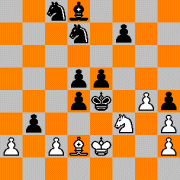 Mate in 14
Mate in 14
A. Popandopulo
Sj.v SSSR, 1969
1.Bh6 Threatening Nd2 mate. 1...Ba5 2.Ng5+ Kf4 3.Nxf7+ Ke4 4.Ng5+ Kf4 5.Nf3+ Ke4 and the position after 1...Ba5 is repeated, minus the Pf7. 6.Bc1 Bd8 7.Nd2+ Kf4 8.Nxb3+ Ke4 9.Nd2+ Kf4 10.Nf3+ Ke4 and the position after 6...Bd8 is repeated, minus the Pb3. And now, after 11.a3, Black is in Zugzwang - which is why White removed those two pawns. There follows 11...Nf6 (weakening c5) 12.Nd2+ Kf4 13.Nb3+ Ke4 14.Nc5 mate, or 11...Nd6 (weakening d6) 12.Nd2+ Kf4 13.Nc4+ Ke4 14.Nxd6 mate, or 11...Be7 which puts that Bishop on the wrong foot: 12.Bh6 Bb4 13.axb4 and 14.Nd2 mate.
I can't resist showing a beautiful study with the same Zugzwang theme, although it lacks the repetition.
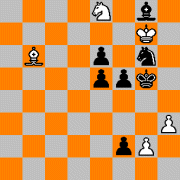 White to play and win
White to play and win
N. Reznichenko
Shakhmaty v SSSR, 1975
1.g3 Threatening the Zwickmühle mate 2.Bd8+ Kh5 3.Nf6+ Kg5 4.Ne4+ Kh5 5.g4+ fxg4 6.Ng3 mate. Black must guard g3. 1...f1N (1...f4 2.Bd8+ and Nd6 or g4 mate) and now 2.Bd8+ Kh5 3.Nf6+ Kg5 4.Nxg8+ Kh5 5.Nf6+ Kg5 6.Ne4+ Kh5 7.Be7! with a stunning Zugzwang. Black can't escape mate in a few moves: 7...fxe4 8.g4 mate, or 7...Nxe7 8.Nf6+ Kg5 9.h4 mate, or 7...Ne3 8.g4+ fxg4 9.Ng3 mate. Just as in Popandopulo's problem, the Zwickmühle-Knight eliminated a piece that would have spoiled the Zugzwang (4.Ne4+? Kh5 5.Be7 Bf7! and White has nothing), after which it was catapulted to the original mating square g3.
Finally, one of the best Zwickmühles in my collection; an intermediate Zwickmühle removes an enemy piece to unguard a square.
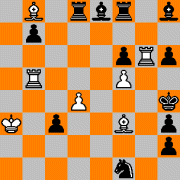 Mate in 13
Mate in 13
W. Baer
2nd Prize, Schach 1977
White has a simple plan: 1.Rxh6+ Kg5 2.Rh5 mate, but of course h5 is guarded. 1.d5 would lure that guard away (1...Bxb5 2.Rb4 mate), except that the Rg6 is en prise and 1...Bxg6 would spoil everything. For b5 to work, the Rook needs some sort of a parking place on the g-file. A Zwickmühle is ready to bring it there - but which square should it be? The whole g-file is guarded. That's where an intermediate Zwickmühle comes in: 1.Rg4+ Kh5 2.Re4+ Kg5 and the new Zwickmühle has been formed, of which the Rook is not the front, but the tail piece. 3.Bf4+ Kh4 4.Bxh2+ Kg5 5.Bf4+ Kh4 6.Bb8+ (the Bishop must guard against Ra8+) 6...Kg5 with the same position as after 2...Kg5, but without the Ph2. And now: 7.Rg4+ Kh5 8.Rg1+ Kh4 and finally White has time for 9.d5 Bxb5 Forced - but h5 now being unguarded, this allows the initial mate: 10.Rg4+ Kh5 11.Rg6+ Kh4 12.Rxh6+ Kg5 13.Rh5 mate.
325. 29 October 2006:
And they used to pull such happy pranks together...
Topalov - Kramnik, Dortmund 1996
1.d4 d5 2.c4 c6 3.Nf3 Nf6 4.Nc3 e6 5.Bg5 dxc4 6.e4 b5 7.e5 h6 8.Bh4 g5 9.Nxg5 hxg5 10.Bxg5 Nbd7 11.exf6 Bb7 12.g3 c5 13.d5 Qb6 14.Bg2 O-O-O 15.O-O b4 16.Rb1 Qa6 17.dxe6 Bxg2 18.e7 Bxf1 19.Qd5 Bxe7 20.fxe7 Bd3 21.Ne4 Bxb1 22.Nd6+ Kc7 23.Bf4 Kb6 24.Nxc4+ Kb5 25.Nd6+ Kb6
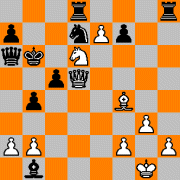
26.exd8B+ Rxd8 27.Nc4+ Kb5 28.Nd6+ Kb6 29.Nc4+ Kb5 draw
|
Kramnik - Topalov, Dortmund 1997
1.Nf3 Nf6 2.c4 g6 3.Nc3 Bg7 4.e4 d6 5.d4 O-O 6.Be2 e5 7.O-O Nc6 8.d5 Ne7 9.b4 a5 10.Ba3 axb4 11.Bxb4 Nd7 12.a4 Bh6 13.a5 f5 14.Nd2 Kh8 15.Bd3 Rf6 16.Na4 Rf7 17.c5 dxc5 18.Bc3 fxe4 19.Bxe4 Nf5 20.Nc4 Nd6 21.Nxe5 Nxe5 22.Bxe5+ Bg7 23.Bxg7+ Rxg7 24.Nxc5 b6 25.Ne6 Bxe6 26.dxe6 Nxe4 27.axb6 cxb6 28.Re1 Nc3 29.e7 Nxd1
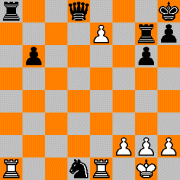
30.exd8B Rxd8 31.Rexd1 Rxd1+ 32.Rxd1 Rb7 33.Kf1 b5 34.Rb1 Kg7 35.Ke2 Kf6 36.Kd3 draw
|
324. 15 September 2006:
A cooked, correct study
That humans and machines have their own truths in chess, is nicely - and accidentally - illustrated in this study.
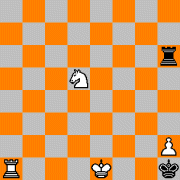 White to play and win
White to play and win
E. Pogosyants
EG 1978
The main variation is ultra-simple and ultra short: 1.Ne3 Rxh2 2.O-O-O mate. There is a side variation: 1...Re6 (Kxh2 2.Ng4+) 2.Kf2+ Kxh2 3.Ng4+ Kh3 4.Kf3 Kh4 5.Kf4 and now 5...Kh3 6.Ra2 or 5...Kh5 6.Kf5 and wins.
But now we have endgame tablebases, and on the tablebase Bulletin Board, Yechiel Robinson points out something very funny about this study.
As he writes, "tablebases do not account for the castling rule because it is a little complicated to include it, and it is not really necessary for practical purposes." Therefore, the tablebase sees the position after 1.Ne3 Rxh2, where White can mate in 1, as a draw.
Study cooked? No, because the tablebase also gives the typical computer move 1.h4! and White mates in 33.
Robinson gives some nice variations: 1...Rxh4 (1...Kg2 2.Ne3+ Kf3 3.Ra3 Re6 4.Kf1 Kg3 5.Ng2 etc.) and Black finds himself with one of those cases where R+N vs. R is lost: 2.Kf2+ Kh2 3.Ra6 Kh3 4.Kf3 Rh7 5.Nf4+ Kh2 6.Kf2 Rh8 7.Rf6 Rh4 8.Rf5 Rh6 9.Ng6 Kh1 10.Nh4 Ra6 (or 10...Rxh4 11.Kg3 with a surprising Saavedra echo) 11.Kg3 Ra3+ 12.Nf3 Ra5 13.Rf4 Ra4 14.Nd4 Ra3+ 15.Kf2 Ra2+ 16.Ne2 and White mates.
So this is a study with two solutions. A human solution that is beyond the grasp of the tablebase, and a tablebase solution that is beyond the grasp of humans.
PS 26 September: As Robinson himself remarked, the human side of the study "can be corrected by placing a Black pawn on g4. This adds an insignificant side variation 1. Ne3 g3 2. Ke2+ Kxh2 3. Ng4+, but otherwise the solution does not change."
And Laurent Linnemer adds that "for [the] tablebase solution to be the only one, just move the R from a1 to b1 (or c1 but not d1 as Rd6 is no longer possible)."
323. 14 September 2006:
Two wonderfully inaccurate definitions
Alastair Scott sends me "two wonderfully inaccurate definitions" from the help file of the chess game Chess Titans that comes with Windows Vista (Release Client 1).
Castling:
Take advantage of castling. In a single move to protect your king, you
can move your king two spaces sideways and your rook to the space that the king skipped over. You can only do this if there are no pieces in between them, neither piece has moved in the game, and your opponent does not gain a more direct attack at the king as a result of the move. Leaving yourself open to attack is called moving into check, and by doing this, you effectively resign the game because surrendering your king gives the victory to your opponent.
En passant:
If a pawn is about to capture one of your pawns that hasn't moved, you may decide to move that pawn forward two squares. If you do, it's more exposed for one turn. During the next turn, your opponent can move to the square where your pawn is, or to the square behind that, and capture your pawn. After that one turn, your pawn is normally vulnerable again. Both armies' pawns are vulnerable this way.
322. 17 August 2006:
A move rarely seen
Thomas Beuman wrote me that when he saw Simenon - Tan (see item 321 below), he had a déjà vu:
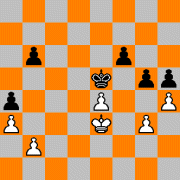 White to play
White to play
Ree - Ftacnik
Kiev 1978
Here, White did see the break-through missed by Simenon: 57.g4! hxg4 58.h5 Ke6 (58...f5 59.h6 f4+ 60.Kf2 Kf6 61.e5+ Kg6 62.e6) 59.Kf2 Kf7 60.Kg3 Kg7 61.Kxg4 Kh6 or 61...b5 62.e5! fxe5 63.Kxg5 etc. 62.Kf5 Kxh5 63.Kxf6 g4 64.e5 g3 65.e6 g2 66.e7 g1Q 67.e8Q+ Kh4 68.Qh8+ Kg3 69.Qg7+ Kf2 70.Qxg1+ Kxg1 71.Ke5 Kf2 72.Kd5 Ke3 73.Kc6 Kd2 74.Kxb6 Kc2 75.Ka5 Kxb2 76.Kxa4 Kc3 77.Kb5 and Black resigned.
Searching in my database, I discovered that this rather obvious move was missed in sixteen out of seventeen other opportunities. In chronological order:
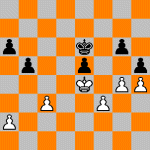 Black to play
Black to play
Ingerslev - Rath
ch Denmark 1975
Black could have won with 43...g5; after 43...a5? 44.gxh5 gxh5 45.f4 exf4 46.Kxf4 etc. the game ended in a draw.
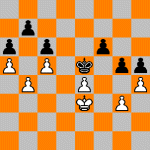 White to play
White to play
Goeldenboog - Modrova
Dortmund 1989
White could have won with 36.g4, but lost after 36.Kd3 gxh4 37.gxh4 Kf4 etc.
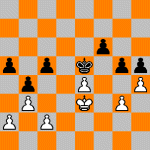 White to play
White to play
Cabello - Arabi, 1991
Almost identical to the one before. White resigned after 32.Kd3 gxh4 33.gxh4 Kf4, when he could have won with 32.g4!
 White to play
White to play
Vlahos - Tzoumbas
Katerini 1993
After 38.b3? bxa4 39.bxa4 c5 40.dxc5 Kxc5 41.Kc3 g5 White resigned; 38.b4! would have won: 38...axb4 39.a5 Kd6 40.Kc2 Kc7 41.Kb3 Kb7 42.Kxb4 Ka6 and now 43.Kc5? only leads to a draw because the pawn situation on the other wing is not favorable, but first 43.f4! wins as before.
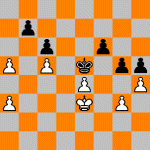 White to play
White to play
Kaufmann - Rogobete
Lichtenfels 1994
53.g4 was winning; after 53.a4? gxh4 54.gxh4 f5 and several mistakes by both sides, Black won.
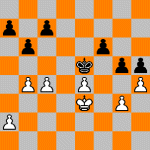 White to play
White to play
Vagner - Brazina
Prerov 1994
After 30.a3 gxh4 31.gxh4 c6 32.a4 c5 (isn't a6 winning?) 33.b5 f5 34.exf5 Kxf5 35.Kf3 Ke5 a draw was agreed; 30.g4! would have won.
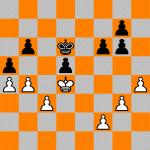 Black to play
Black to play
Roman - AliBaba
ICC blitz 1995
After 37...Kc6 38.g4 Kd6 39.bxa5 bxa5 40.c4 dxc4 41.Kxc4 Kc6 42.g5 Black resigned; 37... b5 was winning.
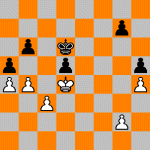 Black to play
Black to play
Kovacs - Jamrich
Hungary 1995
After 40...Kc6? 41.Ke5 Black resigned; 40...b5 was winning.
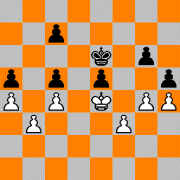 Black to play
Black to play
Hefka - Rachela
Slovakia 1995
The only other case where it was seen - because it was a correspondence game? Black won after 41...g5 42.hxg5 h4 43.Ke3 Kf7 44.Kf2 Kg6 45.Kg2 Kxg5 46.Kh3 c6 Perhaps even easier than the more thematic 46... Kf4 47.Kxh4 Kxf3 48.g5 e4 49.g6 e3 50.g7 e2 51.g8Q e1Q+ 52.Kh5 Qh1+ 53.Kg6 Qg2+ 54.Kh7 Qxg8+ 55.Kxg8 Ke4 56.Kf7 Kd4 57.Ke6 Kc3 58.Kd5 Kxb3 59.Kxc5 Kxa4 etc. 47.Kg2 e4 48.fxe4 Kxg4 49.e5 Kf5 50.e6 Kxe6 51.Kh3 Ke5 52.Kxh4 Kd4 53.Kg4 Kc3 and White resigned.
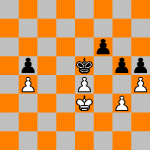 White to play
White to play
Andersen - Matthiesen
Aarhus 1997
After 44.Kd3 gxh4 45.gxh4 Kf4 46.Kd4 Kg4 47.Kc5 Kxh4 48.Kxb5 Kg5 49.Kc5 h4 50.b5 h3 51.b6
h2 52.b7 h1Q 53.b8Q Qxe4 White eventually lost the endgame; with 44.g4 he could have won.
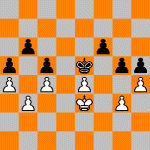 White to play
White to play
Jurcak - Federic
Zilina 1997
37.Kd3? gxh4 38.gxh4 f5 39.exf5 Kxf5 was an easy win for Black; with 37.g4 White could have won.
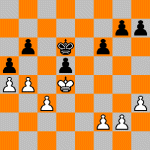 Black to play
Black to play
Cordes - Heinicke
Hiddenhau 1998
After 30...Kc6 31.f4 g6 32.g3 Kd6 33.bxa5 bxa5 a draw was agreed; 30... b5 would have won.
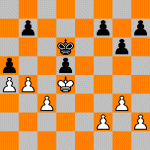 Black to play
Black to play
Popovic - Scekic
ch-Servia, Kragujevac 2000
A very strange case. There followed 36...b6 37.f4 f5 38.h3 h6 39.Kd3 Kd7 40.Ke2 Ke7 41.Ke3 Ke6 42.Kd3 Kd7 43.Ke2 Ke7 44.Kd3 Kd7 draw. No less than six times, on moves 36, 37, 38, 39, 40 and 43, Black missed the winning b5.
Even stranger is that the game Vojinovic - Grujic, played in the same round of that tournament, was a move-for-move copy of Popovic - Scekic, including all the missed b5's. Among pre-arranged draws the stupidest one I ever saw.
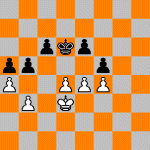 White to play
White to play
Rietveld - Leenman
Hengelo 2000
Here, the winning break-through would have needed preparation: 39.exf5 exf5 (or 39...bxa4 40.bxa4 exf5 41.Kc4 and wins) 40.b4 axb4 41.a5 etc. and White wins. He didn't see it, and lost after 39.Ke3 bxa4 40.bxa4 c5 41.dxc5+ Kxc5 and some more moves.
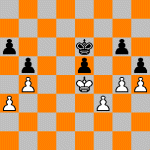 Black to play
Black to play
Altamirano - Garzon
ch Argentina 2003
After 42... Kd6, White had an easy win: 43.gxh5 gxh5 44.f4 exf4 45.Kxf4 etc. With 42...g5, Black could have won.
Of course, this had been shown long before by the endgame specialists - in fact, this last example is an exact replica (be it with he colors reversed) of the premiere of this break-through.
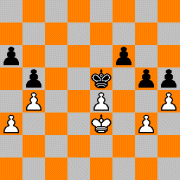 White to play and win
White to play and win
C. Salvioli
Trattato Completo dei Finali di Partita, 1888
This is the appropriate place to give the side variations.
1.g4 hxg4 or 1... gxh4 2.gxh5 h3 3.Kf3 f5 4.h6 Kf6 5.exf5 etc. 2.h5 Ke6 or
2...f5 3.h6 f4+ 4.Kf2 Kf6 5.e5+ Kg6 6.e6 etc. 3.Kf2 Kf7 4.Kg3 Kg7 5.Kxg4 Kh6 6.Kf5 Kxh5 or 6...Kg7 7.e5 fxe5 8.Kxg5 7.Kxf6 g4 8.e5 g3 9.e6 g2 10.e7 g1Q 11.e8Q+ Kh4 12.Qh8+ Kg3 13.Qg8+ and White wins.
It seems not too much can be done with this theme. Almost 100 years later, Evreinov added one little finesse.
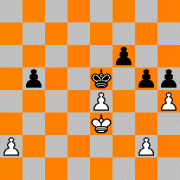 White to play and win
White to play and win
V. Evreinov
Sachove Umenie 1979
1.g4! hxg4 2.h5 Ke6 3.a3! Necessary, because after 3.Kf2? b4! 4.Kg3 Kf7 5.Kxg4 Kg7 6.e5 fxe5 7.Kxg5 e4 8.Kf4 Kh6 9.Kxe4 Kxh5 10.Kd4 Kg6 11.Kc4 Kf7 12.Kxb4 Ke7 13.Kb5 Kd7 14.Kb6 Kc8, Black will draw. But now: 3... Kf7 4.Kf2 Kg7 5.Kg3 Kh6 If 5...Kh7, then 6.Kxg4 Kh6 7.Kf5 etc. and wins as before. 6.Kxg4 Kg7 7.e5 With the pawns on a3 and b5, instead of on a2 and b4, this wins. 7...fxe5 8.Kxg5 e4 9.Kf4 Kh6 10.Kxe4 Kxh5 11.Kd5 Kg5 12.Kc5 Kf5 13.Kxb5 Ke6 14.Kc6 and wins.
PS: After uploading the above, I was so careless as to ignore an important writer's maxim: never spoil a good story with research. When I looked in some other databases, I found ten other cases, in six-and-a-half of which Salvioli's move was played. Italicizing the finder's name: Simic - P. Nikolic, Vrsac 1981; Gruebner - Nothnagel, Hessen 1989; Lugovoi - Gavrilov, Russia 1992; Windhofer - Bauer, Werfen 1992; Arya Nezhad - Sobhani, ch Iran 1993; Stutz - Goetz, Germany 1998 - the last game being from a girls-under-15 championship. The break-through was not seen in (non-finder's names in italics) Graf - Klovan, Army team ch 1990 (Klovan agreed to a draw when he could have played the winning 50...b5); Schmitt - Reinoehl, Germany 1991 and Müller - Tamm, Germany 1992.
It was half-seen in this game:
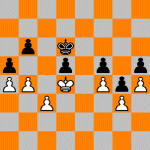 Black to play
Black to play
Zumpe - Fengler
Correspondence, 1988
Strangely, especially for a correspondence game, there followed: 40...b5! 41.axb5 a4 42.Kd3 a3?? (42...Kc7 43.Kc2 Kb6 44.Kb2 Kxb5 45.Ka3 Kc4 etc. wins of course) 43.Kc2 a2 44.Kb2 and Black resigned after a few more moves.
PS 28 August: Yoram Shachar sent me another, quite special example.
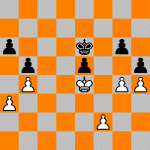 White to play
White to play
Livshitz - Zifroni
Herzelia U14 ch 1986
Instead of winning with 42.gxh5 gxh5 43.f3, White played 42.f3? There followed 42...g5! 43.gxh5 (hxg5 h4 etc.) 43...gxh4 44.h6 Kf7 45.f4 h3 46.Kf3 e4+ 47.Kg3 e3 and White resigned.
After 42.f3, the exact position of Altamirano - Garzon (see above) arises, and on the same move number, making it another copy of Salvioli's 1888 study. Even more interesting is that Zifroni, when he played the Move, was only ten years old. He is now a grandmaster - Livshitz, who lives in Canada now, has become an IM.
PS 8 November: Another, recent example, and at a high level.
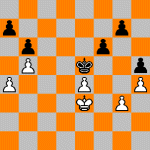 Black to play
Black to play
Welling - Eingorn
Bad Wiessee, 6 November 2006
The position is completely drawn, but after the winning attempt 45...g5?, White did not miss his chance: 46.g4! After thinking for an hour, Black resigned.
PS 19 November: Gerard Welling writes: "Of course I had seen the theme a few weeks ago on your site. During the game I wasn't completely sure that it was exactly the same, but once you've seen a theme, it is generally not so difficult to calculate it. I'd like to add one thing, though. After thinking for a minute, poor Eingorn started mumbling to himself, apparently having calculated all the variations and realizing the unpleasant truth. He kept thinking a little longer - I'd say for a minute or 10 - after which he resigned in a gentlemanly manner. However, the electronic board and clock were not switched off - there was no arbiter around - which has created the impression that Eingorn thought for an hour after g4. That is not true.
Unfortunately, we will never know if I would have seen g4 without prior knowledge."
PS 23 October 2007: The strongest player ever to have missed the g4-move, Charles Sullivan writes, might be Keres, in unison with Bondarevsky, and in analysis.
In his 1974 Practical Chess Endings, Keres analyzes the game Lisitsin - Capablanca, Moscow 1935.
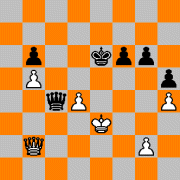 White to play
White to play
Lisitsin - Capablanca
Moscow 1935
After 58.g3, White quickly lost: 58...g5 59.hxg5 fxg5 60.Qh2 Qb3+ 61.Ke4 g4 62.Qe2 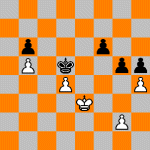 Qxg3 63.Qc4+ Ke7 64.Qc8 Qf3+ 65.Ke5 Qf6+ 66.Kd5 Qd6+ and White resigned. But, Keres writes, "Bondarevsky has recommended a more active defence for White by means of 58.Qb1!, certainly giving White better prospects than the game continuation. After 58...Qc3+ 59.Qd3 Qxd3+ 60.Kxd3 Kd5, Black wins the ending: 61.Ke3 g5!"
Qxg3 63.Qc4+ Ke7 64.Qc8 Qf3+ 65.Ke5 Qf6+ 66.Kd5 Qd6+ and White resigned. But, Keres writes, "Bondarevsky has recommended a more active defence for White by means of 58.Qb1!, certainly giving White better prospects than the game continuation. After 58...Qc3+ 59.Qd3 Qxd3+ 60.Kxd3 Kd5, Black wins the ending: 61.Ke3 g5!"
see diagram right
But, as we have seen, White then wins with 62.g4!
In the meantime, there have been three new cases, in two of which the g4-move was missed.
 Black to play
Black to play
Andromak - Paradjina
Solin (Croatia), 2007
Black had just played 31...b7-b5? and there followed 32.f3? h5? 33.h4?; Black offering the opportunity twice, and White missing it twice. After 33...bxa4, the game was drawn in a few more moves.
 White to play
White to play
Torkilseng - Eggerud
Arctic Chess Challenge, Tromsö 2007
White could win with 37.bxa5 bxa5 38.c3! Kc6 39.c4 etc. He blundered instead with 37.c3?, but Black missed his chance with 37...Kc6?, and after 38.bxa5 bxa5 39.c4 dxc4 40.Kxc4 Kb6 41.Kd5 Kb7 42.Kc5 Kc7 43.Kb5 Kd6 44.Kxa5 Kc5 45.Ka6 Kc6 46.a5 Kc7 47.Kb5 Kb7 48.Kc5 he had to resign. Of course, Black could have won with 37...b5!
 White to play
White to play
Schmitz - Fedorovsky
Munich, 2007
White had to take the draw with 36.gxh5. After 36.b3?, Black pounced: 36...g5! 37.gxh5 gxh4 38.h6 Kf7 39.f4 h3 40.Kf3 exf4 and White resigned.
PS 20 November 2020: Gerard Welling made a interesting discovery in an old volume of the Danish magazine Nordisk Skaktidende. Turns out this breakthrough premiered in a game after all, preceding Salvioli by 10 years.
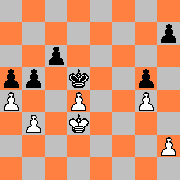 White to play
White to play
Knoff - Bjørnwall
cr 1878
With the h-pawns on h3 and h6, this would be a perfect mirror of Salvioli.
Black had just blundered with b7-b5; there followed: 31.b4! axb4 32.a5 c5 (Kd6 33.Kc2 Kc7 34.Kb3 Kb7 35.Kxb4 Ka6 36.Kc5 Kxa5 37.Kxc6 b4 38.d5 b3 39.d6 b2 40.d7 b1Q 41.d8Q+ Ka4 42.Qa8+ Kb3 43.Qb8+ and wins, as in Salvioli´s main variation) 33.a6 c4+ 34.Kc2 Kc6 35.d5+ and Black resigned.
321. 6 August 2006:
An ultimate outside passed pawn
Patriek Vleeming drew my attention to another recent resignation in a winning position in a Dutch tournament.
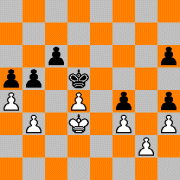 White to play
White to play
Simenon (2061) - Tan (2249)
Schagen, Dutch Junior Championship, May 2006
After 62...b6-b5, White resigned. 63.axb5 cxb5 will give his opponent a winning outside passed pawn, and 63.Kc3 b4+ 64.Kd3 h5 also loses. With 63.b4! however, he could have turned the tables - he would have created a winning outside passed pawn. The main variation then is: 63...axb4 64.a5 Kd6 65.Kc2 Kc7 66.Kb3 Kb7 67.Kxb4 Ka6 68.Kc5 Kxa5 69.Kxc6 b4 70.d5 b3 71.d6 b2 72.d7 b1Q 73.d8Q+ Ka4 74.Qa8+ Kb3 75.Qb7+ Kc2 76.Qxb1+ Kxb1 77.Kd5 and White wins. See the item below and
The ultimate blunder elsewhere on this site.
© Tim Krabbé 2006, 2007
Top |
Main chess page |
Main page |
Contact me
 White to play
White to play